If you fertilize your lawn, you are probably worried about your dogs traipsing through the…
The post 5 Dog-Friendly Fertilizers for Your Lawn appeared first on Earth911.

If you fertilize your lawn, you are probably worried about your dogs traipsing through the…
The post 5 Dog-Friendly Fertilizers for Your Lawn appeared first on Earth911.

This story was co-published with Alaska Public Media.
A dusting of snow clings to the highway as Barbara Schuhmann drives around a hairpin curve near her home in Fairbanks, Alaska. She slows for a patch of ice, explaining that the steep turn is just one of many concerns she has about a looming project that could radically transform Alaskan mining as the state begins looking beyond oil.
Roughly 250 miles to the southeast, plans are developing to dig an open-pit gold mine called Manh Choh, or “big lake” in Upper Tanana Athabascan. Kinross Alaska, the majority owner and operator, will haul the rock on the Alaska Highway and other roads to a processing mill just north of Fairbanks. The route follows the Tanana River across Alaska’s interior, where spruce-covered foothills knuckle below the stark peaks of the Alaska Range. Snowmelt feeds the creeks that form a mosaic of muskeg in nearby Tetlin National Wildlife Refuge, a migration corridor for hundreds of bird species.
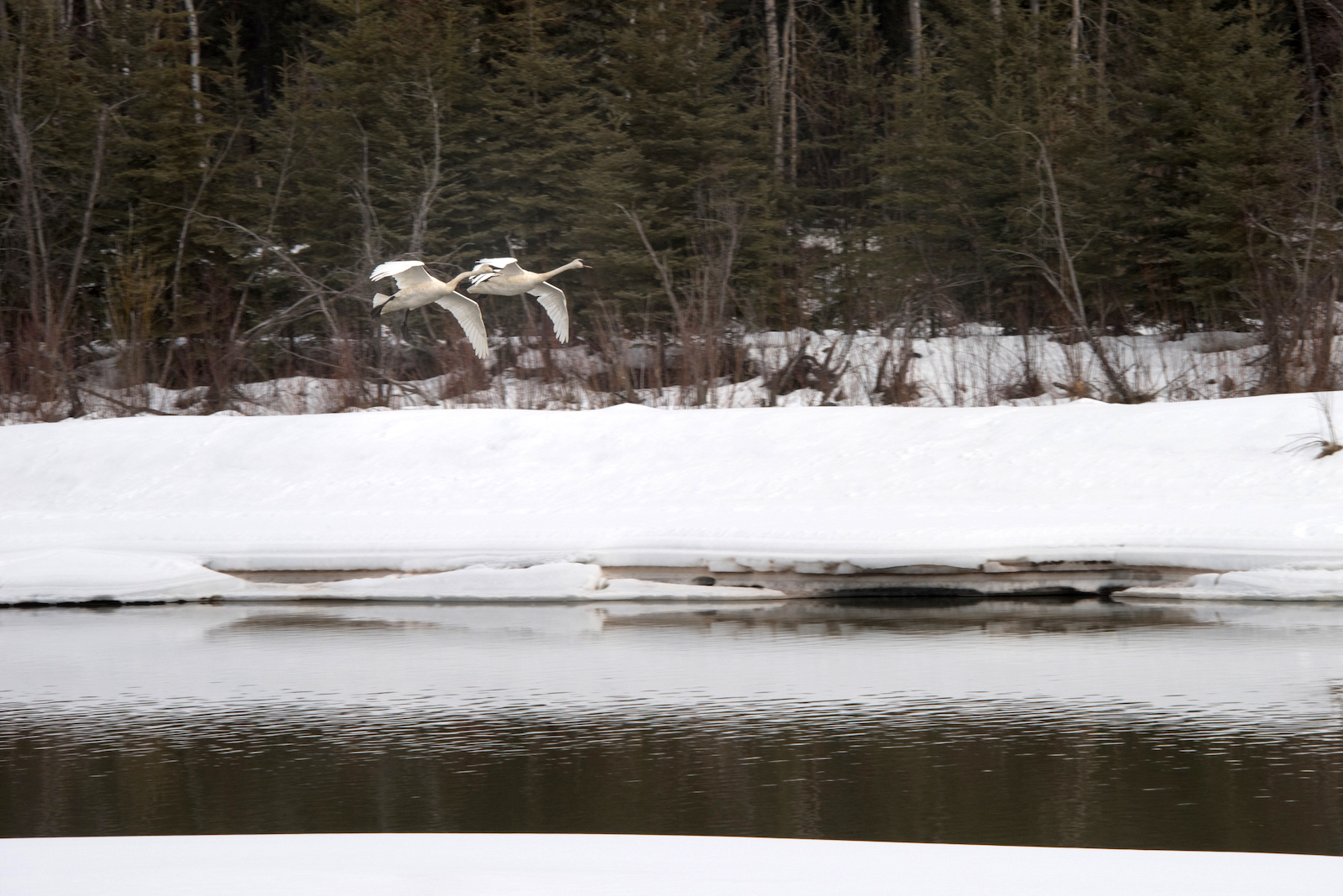
When Schuhmann first heard about the project about a year ago, she was surprised. Kinross’ contracted trucking company, Black Gold Transport, will use customized 95-foot tractor-trailers with 16 axles, which will weigh 80 tons apiece when fully loaded. These trucks will soon rumble by homes and businesses every 12 minutes, 24 hours a day, seven days a week, with trial runs starting this summer. “It sounded pretty crazy at the time, moving a mountain from one area of Alaska to another,” she recalls. “It just seemed unbelievable that this would be allowed without special permitting and safety considerations.”
She doesn’t often bring it up, but Schuhmann knows just how dangerous the road can be. Her husband lost his mother, brother, and sister on that highway when a truck crossed the centerline, hitting their car head-on. “So, accidents happen,” she says.
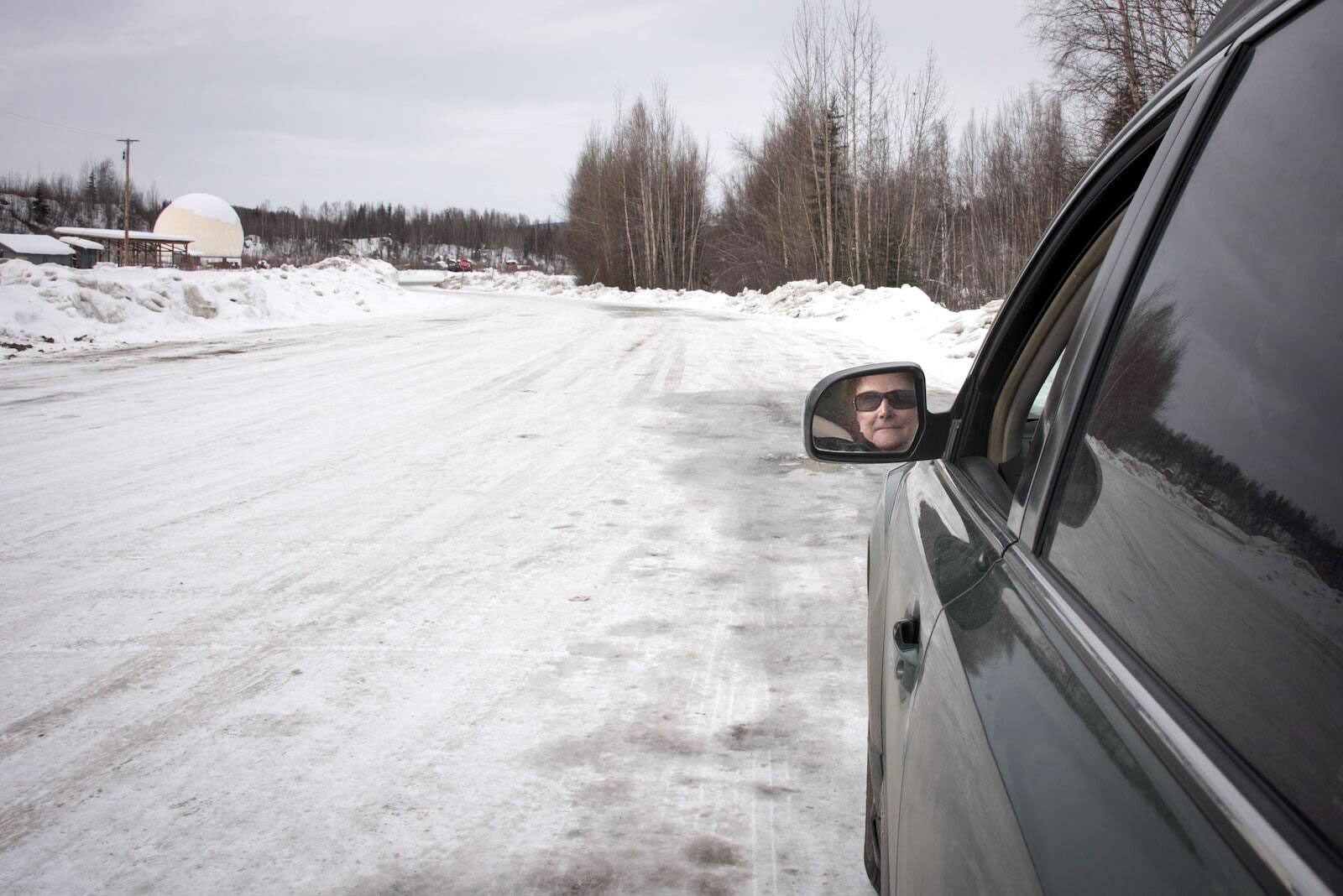
The risks go beyond traffic. The mine and its tailings at Fort Knox, the state’s largest gold mine, have the potential to pollute the air and waterways. But unlike most other mines in the state, there has been no environmental impact statement prepared for Manh Choh. Residents in communities along the route worry about the increased violence and housing shortages that often follow the arrival of such projects. Others question the state’s ability to impartially oversee the permitting process when it has invested $10 million from a state fund in the mine.
Kinross, which declined repeated interview requests and told others not to speak to Grist, says the project will create more than 400 jobs. Supporters point to the economic boost it could bring to the Native Village of Tetlin, which is leasing the land to Kinross, as well as to nearby Tok, home to 1,200 people.
But Manh Choh is just the beginning of a surge in mining projects in the state. While gold is not a critical mineral, Alaska holds large reserves of cobalt, copper, and rare earth minerals essential to the green transition. If Kinross is allowed to use public roads, it will set a precedent for other companies eager to expand — one in which significant health and safety risks are underwritten by taxpayers. Other looming projects, like the planned Ambler Road in the Brooks Range, are already quietly preparing to use the state’s highways.
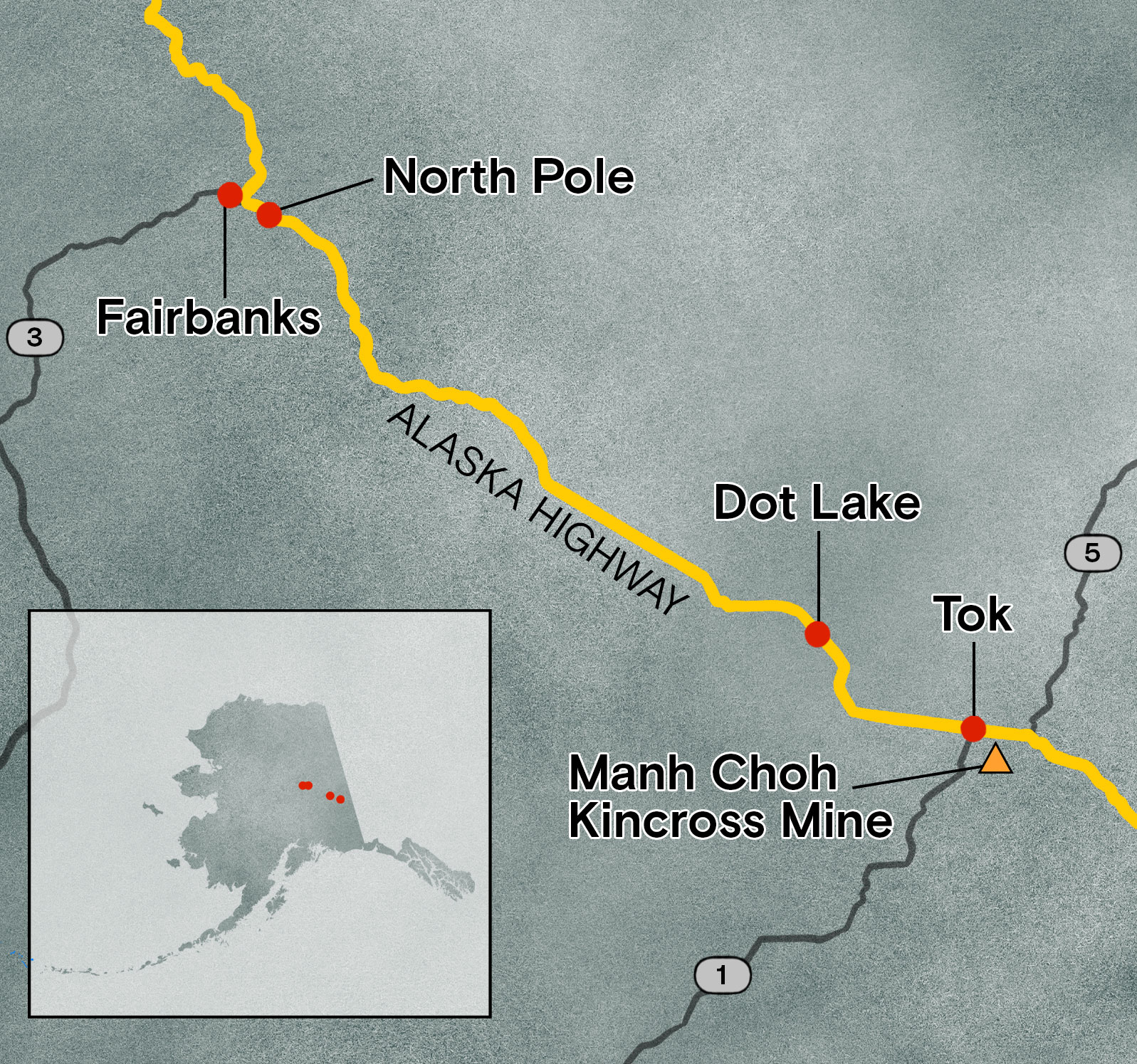
Alaska is at a pivotal moment: Oil and gas production, historically the most important driver of the state’s economy, has been declining for decades. Mining, meanwhile, saw a 23 percent increase in production value in 2021 alone. As the Biden administration pushes to shore up domestic supply chains, Alaskans like Schuhmann aren’t the only ones questioning the race for minerals. She worries the state hasn’t taken the time to make sure that Alaskans can benefit from this kind of development — or at the very least, won’t be harmed by it. “They can’t answer the questions,” Schuhmann said. “And so we just keep trying to ask them.”
Lynn Cornberg adjusts her skis, tucking her chin into the wind. She sets off on a historic trail, just north of where gold was first discovered in Fairbanks in 1902, earning it the nickname “The Golden Heart City.” Spindrifts kick up behind her, crystalline in the below-zero chill. The snow darkens with dust as she approaches Fort Knox, where the original gold deposit is running out. After investing so much in the mine’s mill, however, Kinross is eager to keep it running by processing ore from other sites.
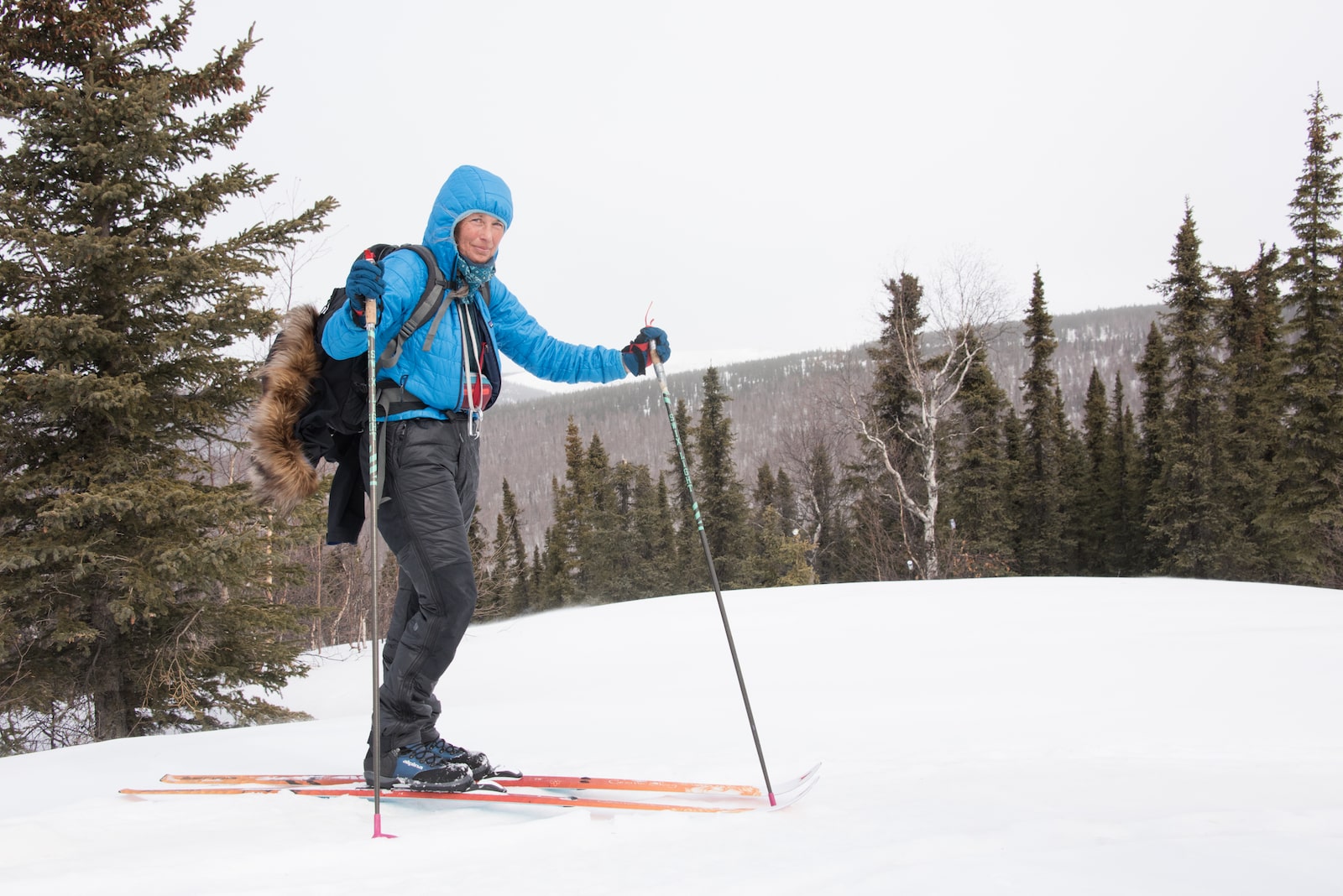
The rumble of huge machinery booms through the forest as the wind whips downhill toward Cornberg’s house. She worries about the risks the rock arriving from Tetlin might pose for her family. In addition to carcinogenic heavy metals, Manh Choh’s ore has the potential to generate acid. Such toxic effluent can continue for millenia. “It goes on generating acid forever,” Schuhmann says. “When you expose this sulfide to the air, it oxidizes. With a little precipitation, it turns to sulfuric acid that kills fish.” This pollution could be a problem not only at the pits in Tetlin, but from dust raised while crushing or transferring the ore to trucks; from whatever blows out of the big rigs on the road; or from processing, stockpiling, or storing the tailings at Fort Knox.
Stanley Taylor, the environmental coordinator for the Native Village of Tetlin, says some village residents were concerned about the risks, and the tribe intentionally outsourced some of the potential hazards to Fort Knox. As the Tetlin Tribal Council wrote in a letter to the Army Corps, “This plan only works because it uses existing infrastructure, the public highway system, and the mill at Fort Knox.” (Tetlin’s chief, Michael Sam, and its tribal council declined repeated interview requests.)
Given these concerns, the project’s environmental review has recently come under scrutiny. Permitting for Manh Choh falls to different state and federal agencies, and there has been no comprehensive look at the project’s full scope. When Fort Knox was first developed in 1993, Kinross conducted an assessment that did not require independent expert review, like an environmental impact statement would have. The permit issued then provided an umbrella for several other mines developed since, with few public details about their operations. Due to Fort Knox’s geochemistry, no one anticipated acid generation. Now, with Manh Choh, “I don’t think any of us [at the Corps’ Alaska district] considered that as a potential impact, that they’re bringing a different type of ore to the mill,” says Gregory Mazer, the project manager for the Army Corps of Engineers.
The Corps’ own review focused on a 5-acre area of wetlands around Manh Choh that did not include the trucking corridor and the tailings at Fort Knox. Both the Environmental Protection Agency, or EPA, and the U.S. Fish and Wildlife Service criticized that decision. The EPA pointedly noted that many other hard-rock mine projects in Alaska have required an environmental impact statement, which “established a precedent which we recommend be considered.” It also suggested that “this project would greatly benefit from a more thorough review.” Both agencies warned about mercury, arsenic, and other heavy metals contaminating waterways, and about the mine’s effect on wildlife, including salmon that spawn in nearby waterways like the Tanana and Tok rivers.

This strategy is known as segmentation, or “dividing up projects so that each little facet of it would have no significant impacts,” says Robin Craig, a professor at the University of Southern California Gould School of Law. “Normally tailings are part of a mining permit,” she says dryly, and “historically in Alaska, tailings affect water quality.” A recent analysis of court cases by environmental law professors at Lewis & Clark Law School argues that the Corps’ pattern of narrowly reviewing projects is inconsistent with the agency’s own National Environmental Policy Act regulations. “Alaska is kind of infamous for letting mining go, regardless of the environmental impacts,” Craig says.
When Schuhmann filed a federal record request in the winter of 2022, for example, she learned that even the agencies involved in the mine’s permitting didn’t have all the information needed to assess its impacts. Kinross had given the Army Corps of Engineers a geochemical report detailing Manh Choh’s potential for acid generation — but experts at U.S. Fish and Wildlife didn’t know about it until Schuhmann gave it to them.
The state Department of Natural Resources routinely publishes links to permits, leases, and environmental audits for other mines, but Schuhmann was the first to share the documents publicly. “I have never considered myself an environmentalist. I mean, my whole working life, I was trying to help people develop their property,” she says. But now, “I am flabbergasted.”
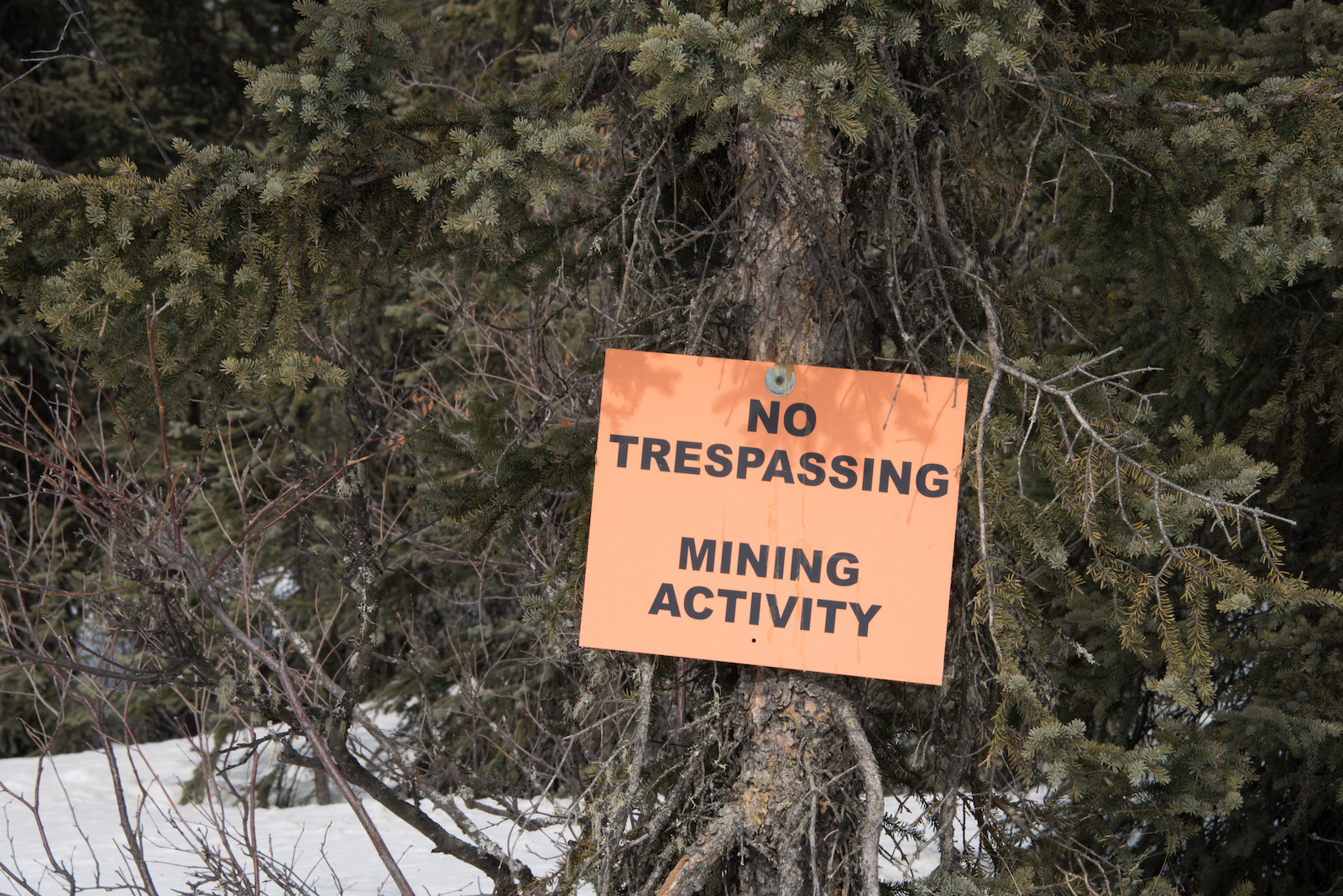
Despite these concerns, Kinross is only required to monitor for acid generation for five years after mining is completed, after which the state will review its condition — a period Craig says is far too short for a problem that can last thousands of years. (The Department of Environmental Conservation says it is limited by state regulations to five-year permits.) Unlike many of the Western states now struggling to deal with acid leaching, she adds, “Alaska is actually in a position to prevent future, lingering, avoidable harm.”
But the state, which has invested $10 million in Manh Choh via Kinross’ junior partner Contango ORE, has been very supportive of the project. One of the trustees involved in managing that state fund, Jason Brune, also leads the agency responsible for issuing Kinross’ waste management permit. (In March, Alaska’s Permanent Fund Corporation board of trustees banned in-state investments to avoid future conflicts of interest.) “Regulatory agencies follow the politics of the administration they work for,” says Dave Chambers, founder of the Center for Science in Public Participation, a nonprofit that provides technical assistance on mining.
And in Alaska, the current administration is decidedly pro-development, a point Governor Mike Dunleavy — who fired an employee for refusing to sign a loyalty pledge — made in an interview with the Fairbanks Daily News-Miner last winter. “There’s too much ‘no.’ No trucks on the road from Tetlin to Fort Knox, no West Susitna Access Road, no Ambler Road,” the governor said. “I need Alaska to say yes to everything.”
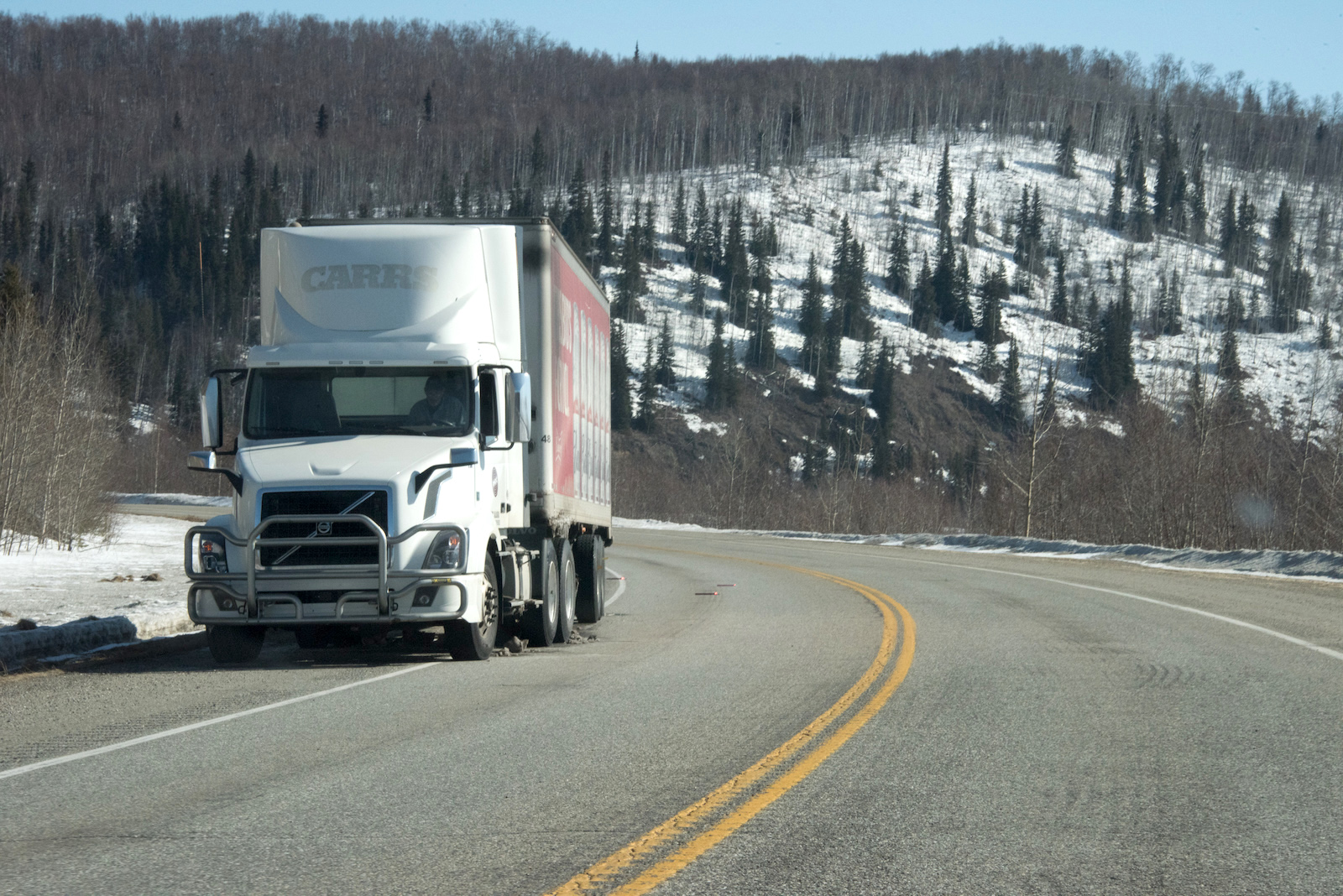
Every year as the ice breaks up across Alaska’s vast Interior, caribou travel from their winter range near Tetlin to their calving grounds. Their tracks crisscross the crust along the highway into Tok, where another kind of migration is under way: White trucks flying orange safety flags zoom into the gas station and pull into Fast Eddy’s, the sole restaurant. Though Kinross isn’t yet processing ore, crews are building a gravel road to the site, where the company has started working. It recently bought a shuttered motel to use as a “man camp,” or employee housing. The wood on its tall, locking fence — built in response to locals’ concerns about the influx of workers — is still raw.
Down the road, Bronk Jorgensen’s log house offers a view of the hill, bristling with dark trees, that will soon be dug out. He grew up in Tok, flying over old claims in the back seat of his dad’s bush plane. It’s always been a “passing-through town,” Jorgensen explains. Tok began as a camp for the construction of the highway during World War II, and eked out a few more jobs when the Trans-Alaska Pipeline was constructed. Now, it’s a stop along what remains the only road to the Lower 48. “This will be the first real industry this community and area has seen on any scale,” he says.

Jorgensen concedes the increased traffic may be inconvenient, but says gold is a commodity, like any other already carried on the road. “If we as a society want to keep living the lifestyle that we live — between electric cars, iPhones, TVs — you know, we need a lot of minerals,” he says. He works a family placer mine, a small-scale operation that extracts gold from a stream bed, and argues that Alaska has far better safety records and environmental standards than other parts of the world. “If we’re going to be consuming these items, we should be responsible and producing them.”
Given his experience moving equipment into remote locations, Kinross hired Jorgensen’s company to help construct the road connecting the mine site to the highway. “Kinross has been very generous in making sure local contractors have had an opportunity to bid part of the work,” Jorgensen says. “The trickle-down economics of this project is going to be huge.”
Communities around Tok are hopeful Kinross will offer coveted year-round employment. The Alaska Department of Labor and Workforce Development recently awarded a $300,000 grant to train residents for potential jobs at Manh Choh. But Larry Mark, one of several hundred Tetlin tribal members, says, “What I’d really like to see is the tribal members have the first priority on jobs. We see all the non-tribal members getting hired left and right.”
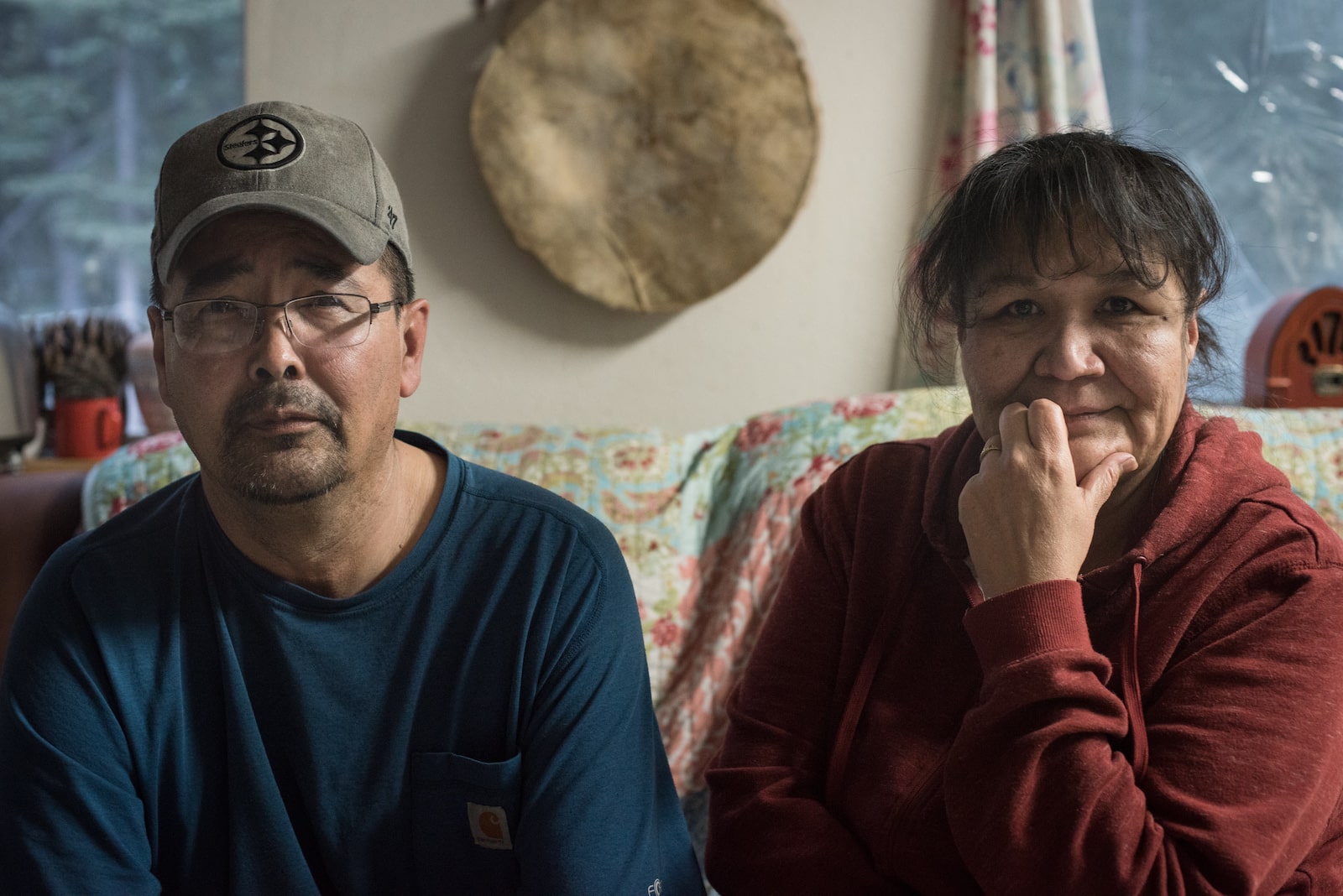
Mark also questions the royalties Tetlin will receive from the project, which are set at a range of 3 to 5 percent. Elsewhere in Alaska, similar endeavors often offer much higher rates, as well as partial ownership. Red Dog, for example, is a large zinc mine leased from the Iñupiat in northwest Alaska, who now receive 35 percent of its net profits. Over half of its employees are tribal members.
Tetlin is in a unique position: Unlike other tribes, it retained its subsurface rights under the 1971 Alaska Native Claims Settlement Act, and negotiated the lease of its land to Kinross directly. “You have small communities with limited resources, responding to large companies with unlimited resources. And it’s very much an imbalance,” says Bob Brean, the former president of the native corporation of Tanacross, a tribe to the west of Tetlin. He spent decades negotiating surface deals for Tanacross with multinational companies like ExxonMobil. He learned the hard way to always demand a profit-sharing formula. “Alaska is still subjected to colonization techniques by big industry,” he says.
Though some tribal members remain enthusiastic about what Manh Choh money could bring to Tetlin — where most of the 130 village residents lack running water or sewer systems — Mark doesn’t feel the village is getting its fair share. “You got to benefit the tribe,” he says, frowning, “and it’s got to be in writing.”
Today, Mark lives in Tok with his adult sons, who come and go as he watches a basketball game, wearing moccasins with a hand-beaded Pittsburgh Steelers logo. “I grew up without electricity,” he says. He learned Upper Tanana Athabascan as his first language, traveled by dog team, and spent his winters trapping. “We’re the richest people there is. We have all the land, we have all the animals — we have everything.”
But Kinross’ bulldozers ran over his traps, costing his family thousands of dollars. Tribal members hunting a moose were recently thwarted by Kinross employees when the animal crossed the company road. Mark worries the ongoing construction will scare away the game his family relies on, especially if Manh Choh is just the beginning of renewed mining in the region. As the price of gold hovers around all-time highs, many old claims, like those scattered through the hill country north of Manh Choh, have become profitable again. “You ever see a miner stop looking for gold?” Mark asks. “They’re going to move to the next hill.”
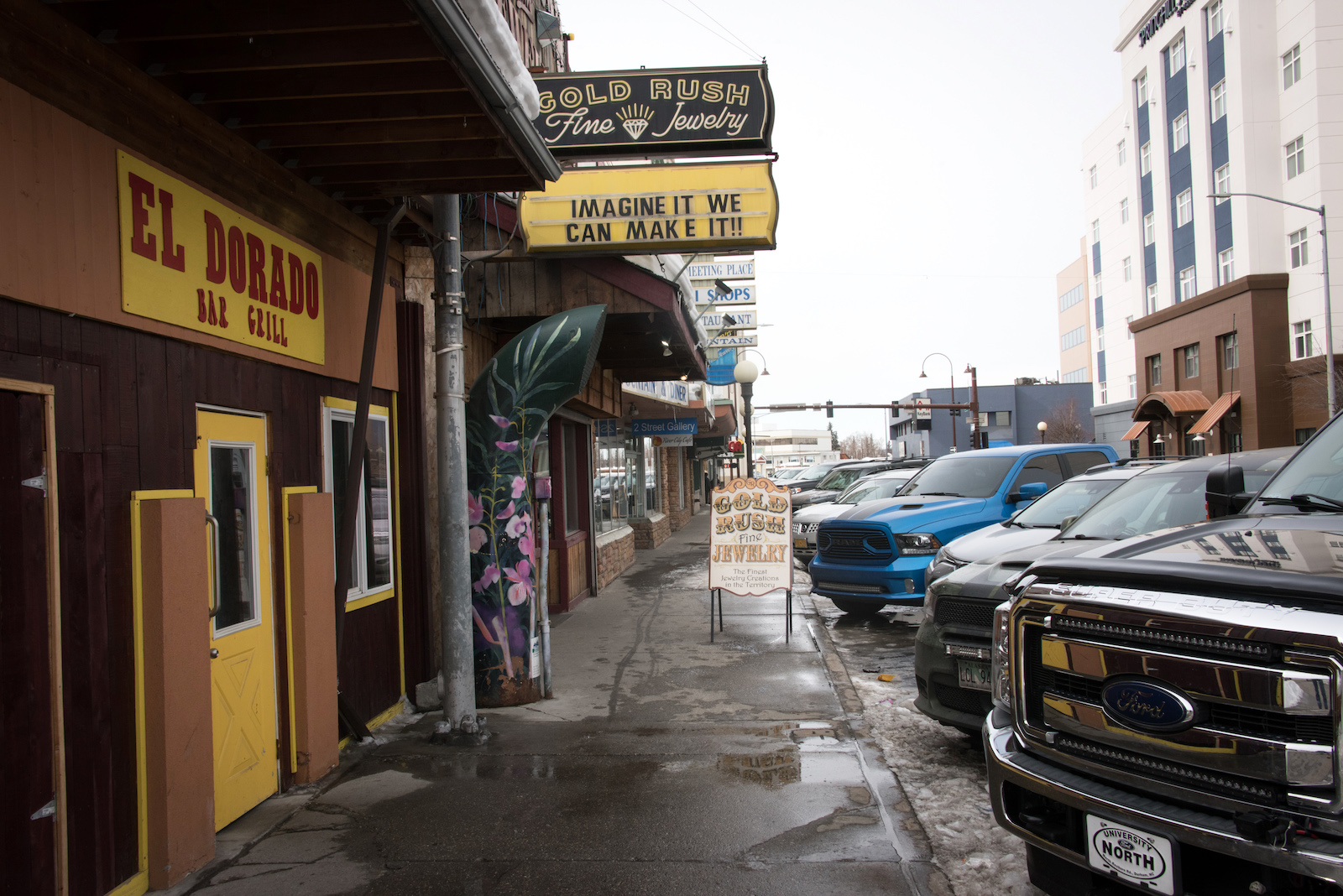
Forty-five minutes west of Tok, over rippling frost heaves and past the skeletons of wildfire, sits the Native Village of Dot Lake. A northern harrier hovers near the small cluster of buildings, its cinnamon belly flashing as it circles, listening for prey. Tracy Charles-Smith, the president of Dot Lake’s tribal council, says Kinross recently asked to speak with the tribe about employment opportunities. She said no. “We don’t have people that want to work in their mine,” she says. “They apparently buy pizza for everybody and whatever. But we can buy our own pizza.”
Traffic blows by Dot Lake’s school at 65 mph. “My tribe is very concerned with cultural and social impacts [of Manh Choh], especially when it has to do with murdered and missing Indigenous women,” Charles-Smith says, citing research that suggests man camps can lead to greater incidences of sexual violence. “We’re pretty much expecting there to be an increase in victims,” she says. The closest hospital that can handle rape cases is 155 miles away in Fairbanks; Charles-Smith says it can take tribal members hours to get there. As a result, Dot Lake is in the process of creating a sexual assault response team.
Alaska already has an ongoing critical shortage of law enforcement in rural areas, and getting a timely response can be difficult. “The increase in the population alone is going to mean that there’s less opportunity for police to respond,” she says.
Other safety questions loom over the route as it winds from Tok to the urban centers of North Pole and Fairbanks. It’s primarily a two-lane ribbon of pavement with few passing lanes, and there are no alternative roads — for many, it’s a lifeline to a hospital, airport, or grocery store. The Alaska Department of Transportation and Public Facilities has made plans to fast-track the replacement of five bridges along the way, including two that the agency says are specifically to accommodate the ore haul. The Federal Highway Administration recently took issue with Alaska’s ratings standards for bridges. Alaska is the only state with no maximum load limit, which could result in trucks carrying more than the federal agency allows, possibly damaging structures over time. (The state has agreed to a plan with the federal agency to come into compliance.)
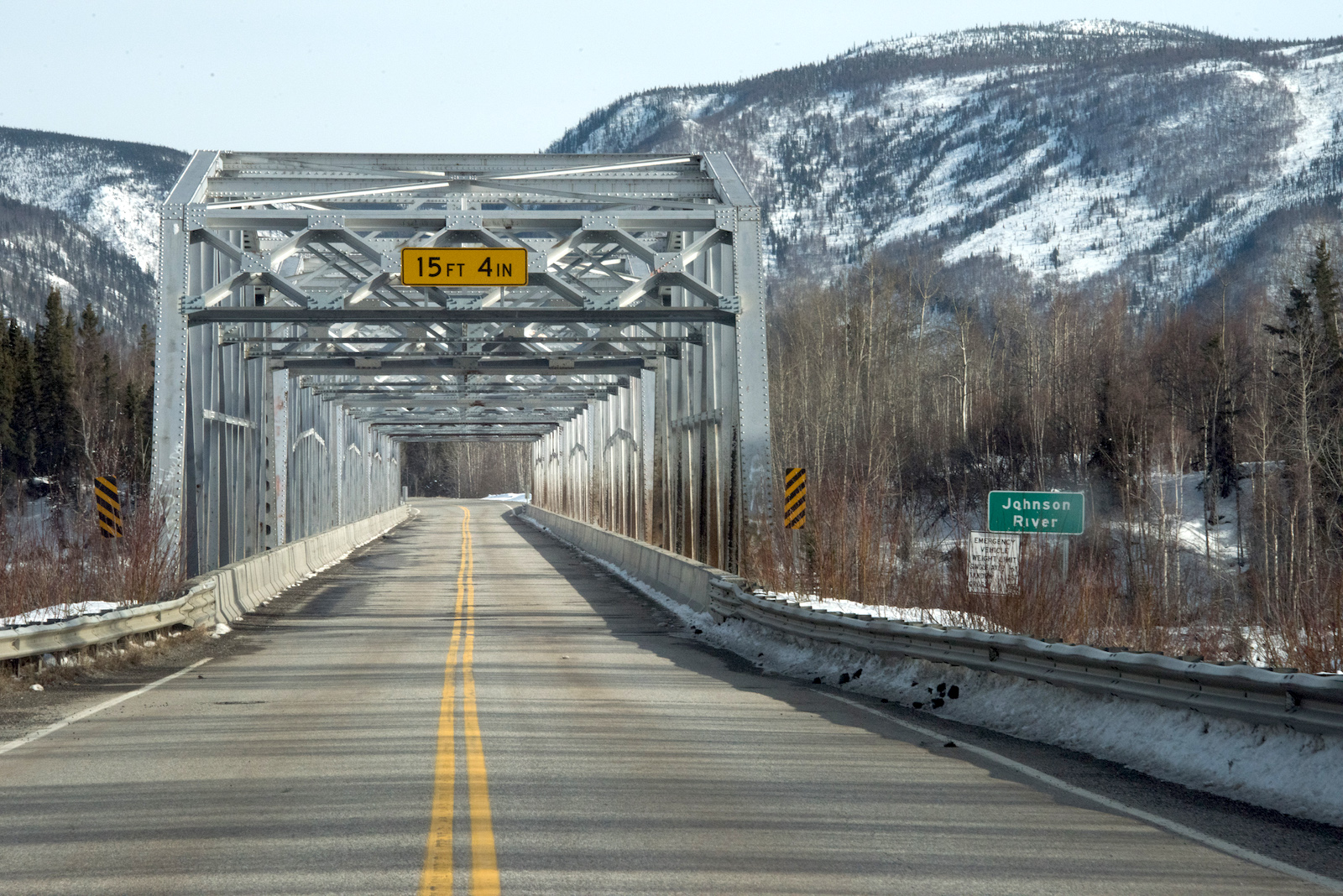
The DOT brushed away Barbara Schuhmann’s questions about these bridges last fall. During that same timeframe, the agency’s staff was working on a weekly basis with Kinross to provide engineering support for the project. “It’s kind of disconcerting that they’ve worked so hand-in-glove with Kinross, and yet they’re not forthcoming with the public,” Schuhmann says.
Three of these bridges were built during the 1940s. Their replacements aren’t likely to be completed until 2027. One of them is so narrow that the local custom is to wait for oncoming traffic to clear before starting across. The Department of Transportation places the price of the infrastructure upgrades at more than $317 million. None will be completed before the first trucks roll later this summer, or even before the mine reaches full production next year.
Retired DOT engineer Bob McHattie, who oversaw this stretch of highway during his decades at the agency, says that based upon his experience with haul roads, ongoing maintenance will add to those expenses — a point the agency concedes. Kinross will increase traffic on the road by as much as 20 percent. “Those big trucks will be the highway traffic between the mine and Fairbanks,” McHattie says. “Those will be the vehicles that are wearing out the road.” In states with less permissive load formulas, he believes, based on his experience, that “it probably wouldn’t be legal.”
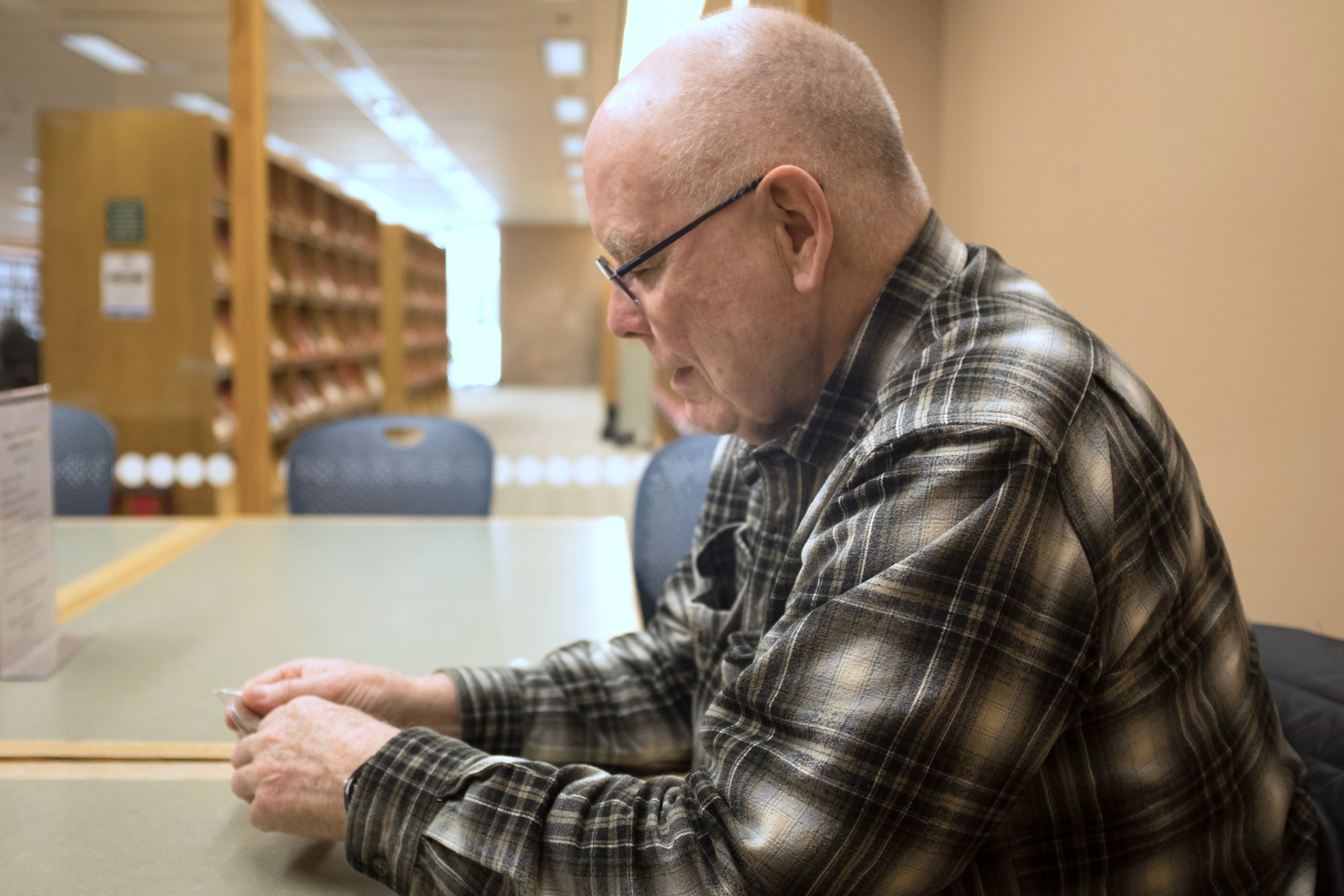
The DOT says it doesn’t know how much this will ultimately cost Alaska, which has a budget crisis. To help pay for safety measures like additional plowing, the DOT could levy a toll on trucks using regulations already on the books. Kinross, meanwhile, has suggested the state increase its fuel tax on the general public.
Feeling like state officials were not taking these concerns seriously, Schuhmann helped form a group called Advocates for Safe Alaska Highways. Its members make unusual allies, with viewpoints spanning the political spectrum. Most, Schuhmann hastens to add, support mining. “We’re not out to get anybody, we’re not anti-mining,” she says. “We just want some common sense and safety to be injected into the whole situation.” Among balloons left over from her granddaughter’s birthday party, piles of paperwork have taken over a corner of her kitchen table. “From the beginning, we’ve asked, ‘What’s your transportation plan? What’s your safety plan?’ And we’ve never seen it in writing,” she says.
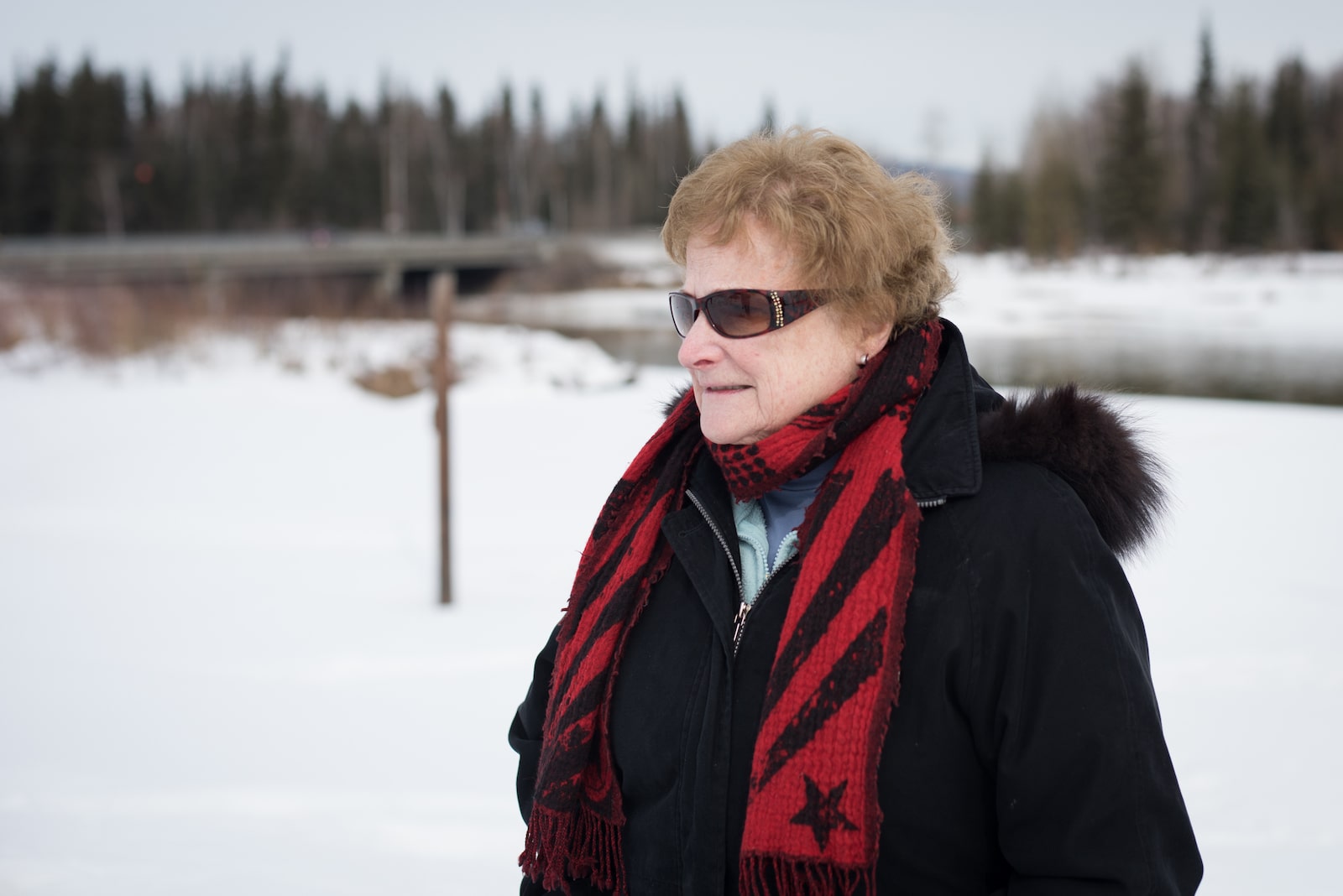
After much pleading from Advocates for Safe Alaska Highways, the DOT hired consulting firm Kinney Engineering to study the potential impacts to roadway infrastructure and safety. The assessment likely won’t be completed before the ore haul begins, but preliminary findings suggest the added traffic will increase crashes. In addition to road conditions, Kinney will also examine factors like the rise in air pollution. Coal-fired power plants, wood-burning stoves, and frequent air inversions have left the Fairbanks North Star Borough with some of the worst air in the country. The Environmental Protection Agency recently warned the borough it may lose $37 million in federal highway funding each year if it doesn’t come into compliance — just as the haul trucks and their emissions hit the road. “At this point, we really do not have the problem defined well enough to come up with solutions,” says Randy Kinney, founder of Kinney Engineering.
These concerns prompted the North Pole City Council and the Fairbanks North Star Borough Assembly to pass nonbinding resolutions opposing the ore haul last winter, although the borough’s language was softened after a new assembly member received a torrent of angry calls from fellow Republicans. A Kinross representative attended the borough meeting as it was being discussed and reminded everyone that the company is the community’s largest taxpayer. “I asked, ‘Oh, do you think we should treat people differently if they pay more in taxes?’” recalls assemblymember Savannah Fletcher. The opposition was symbolic anyway, she says. “We don’t have the ability to limit who can use these public roadways.”
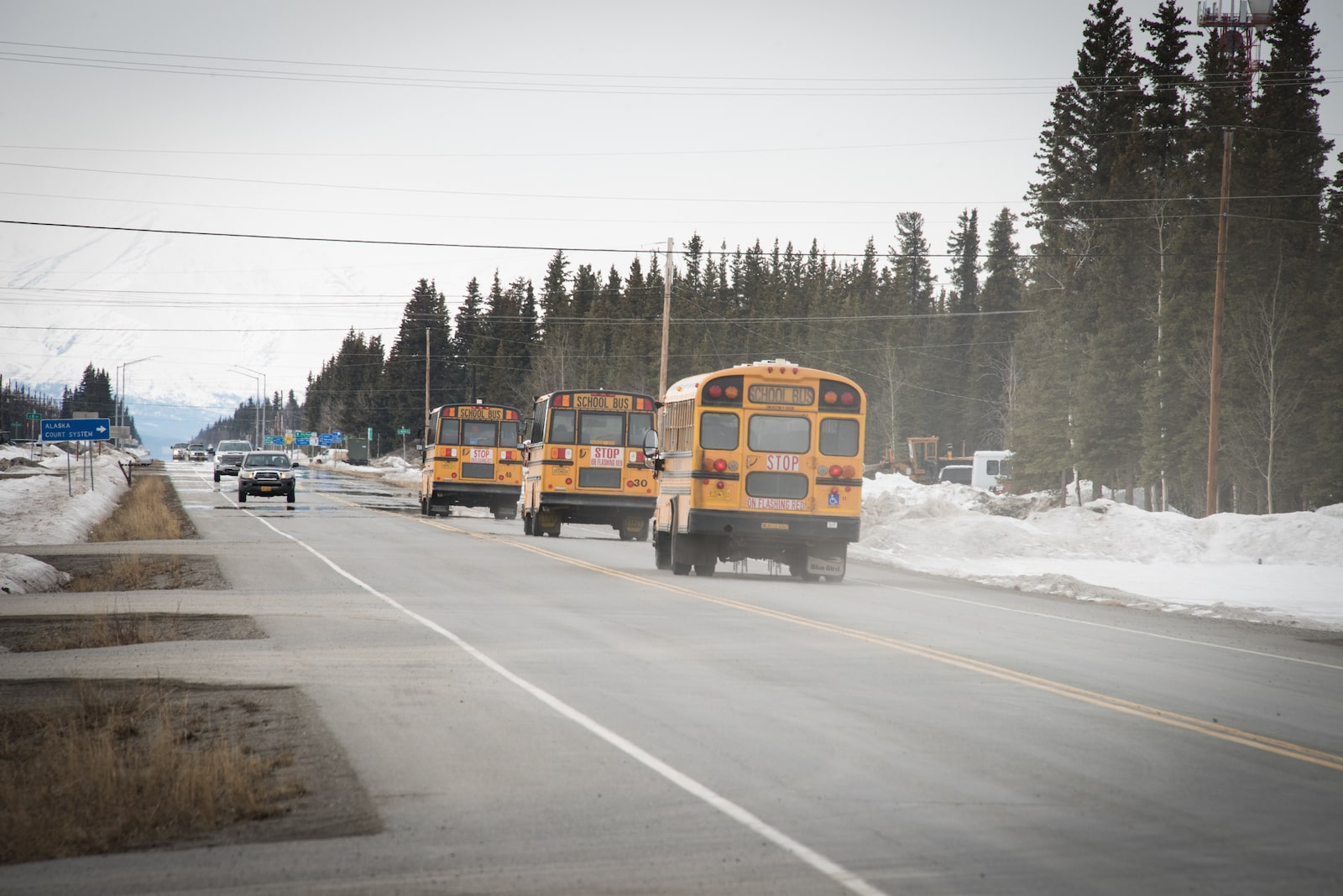
Schuhmann argues that the length of the trailers that will haul the ore normally would prohibit Kinross from using the planned route. (The agency claims a clause in state transportation regulations allows long combination vehicles like those Black Gold Transport will deploy to use several primary roads through the heart of Fairbanks. Schuhmann counters that another regulation provides sweeping authority to keep any vehicle off the road in the interest of public safety.) Kinney estimates the ore trucks — passing a dozen traffic signals, over 100 school bus stops, and many driveways through Fairbanks and all along the route — will need at least 365 feet to come to a stop during the winter. Meanwhile, drivers experienced with Arctic roads are already in short supply; the Alaska Trucking Association estimates that the state is currently 500 short of its needs.
If these trucks have to brake rapidly, they run the risk of jack-knifing, or having the trailer spin forward of the cab. To explain the potential risks, DOT veteran McHattie wrote a tongue-in-cheek poem about Santa’s sleigh running into just such a rig near Dot Lake. “There lies Santa, buried by ore,” he wrote. “Just let the alternative sink into your head. It could have been you and your family instead!”
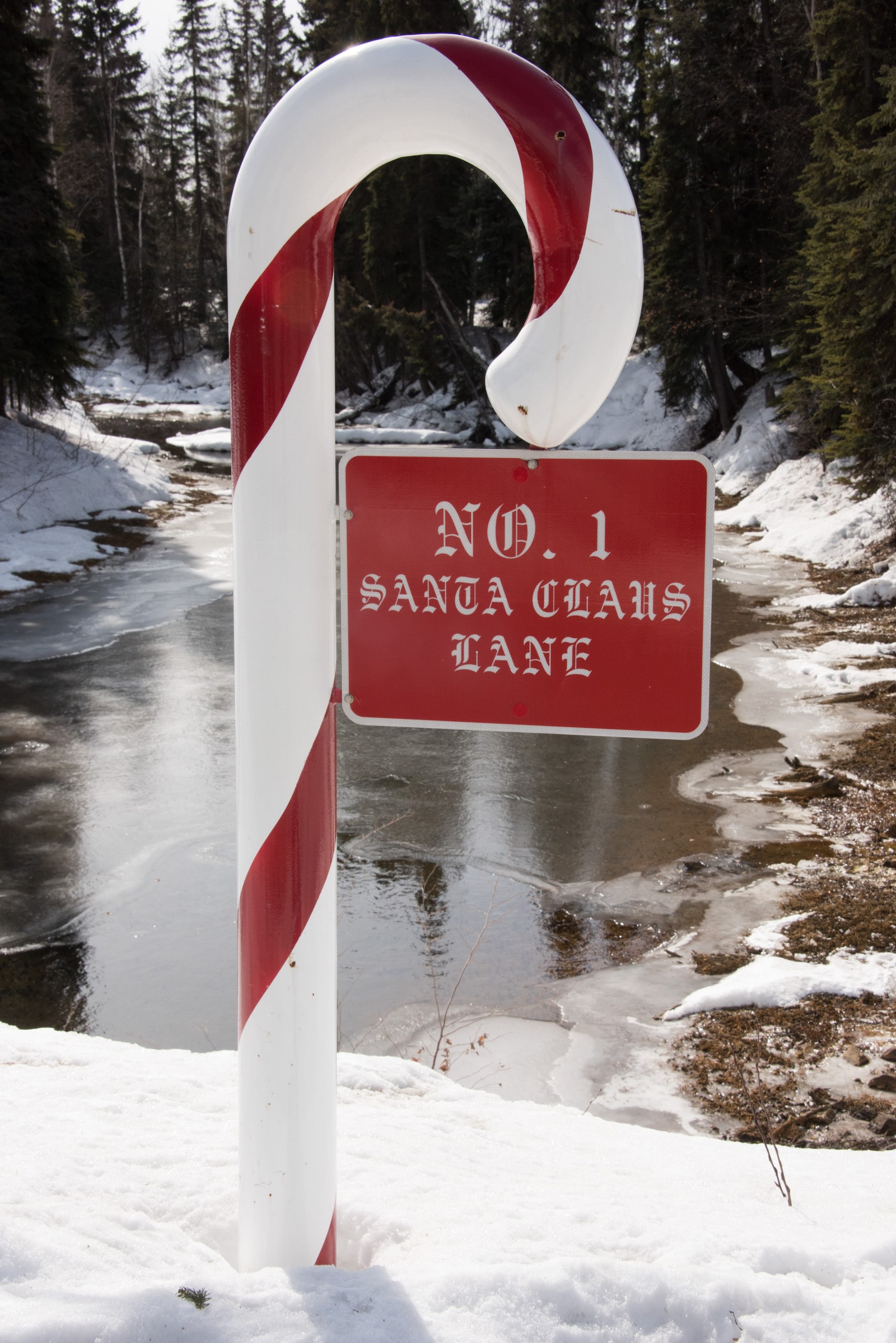
The dark humor helps with his cynicism. “They’re going to kill folks on my highways,” McHattie says. Though he’s a staunch conservative, joining Advocates for Safe Alaska Highways has changed his general outlook, especially “on things that can hurt people.” Later, he pulls out a gold coin. It’s cold and surprisingly heavy. Since Kinross has obtained the necessary permits, he’s fatalistic about the group’s chances of stopping the project. “People have been killing each other for thousands of years over gold,” he says. “This up here is just a much, much watered-down version.”
Fort Knox’s pit is so deep it’s difficult to see the bottom, even when flying overhead in a two-seat Cessna. The scars of old placer mines are pockmarked by recent exploration holes, as Kinross expands its footprint. The ore from another new — and also potentially acid-generating — deposit stands out, a darker brown framed by snow.
Alaska’s mines produced $4.5 billion worth of minerals last year. But mining contributes less than 1 percent of state revenue, which in 2021 came to $83 million. The base tax structure for that sector has remained largely unchanged since Alaska became a state in 1959. “There’s probably a lot of merit in revisiting many of the tax structures we have in the state of Alaska,” says state Representative Ashley Carrick, noting that Kinross and its supporters have worked to emphasize mining’s role in the region’s economy. “We have to really think about how we balance the past and current industries with what we want the long-term future to look like,” she adds. She notes, for example, that using highways as haul routes is in direct conflict with the tourism industry. Yet, she says, “Kinross and Contango do not seem moved by the public outcry.”
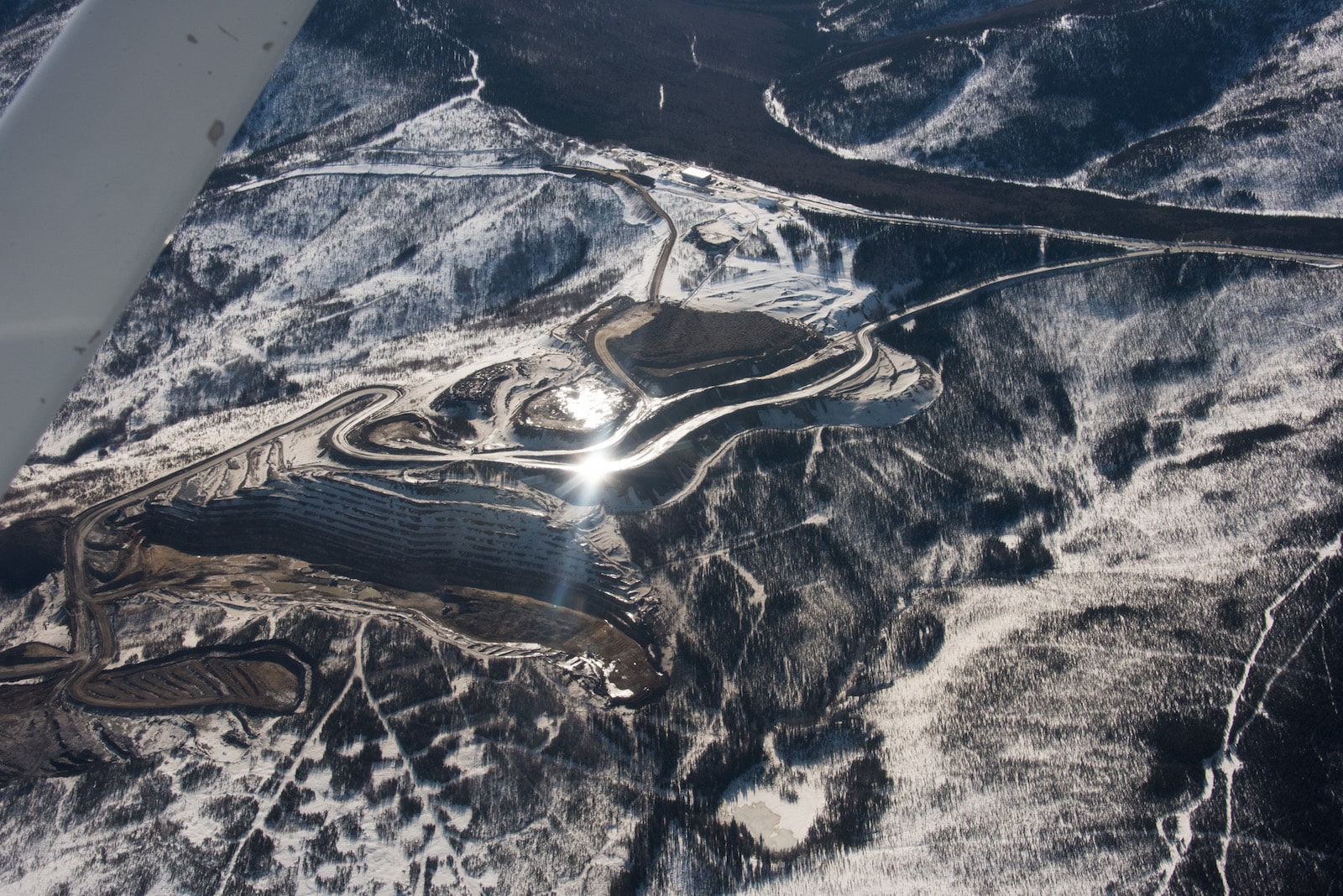
Questions about the role mining will play in Alaska’s economy grow increasingly urgent as companies use the lure of rare earth metals as an excuse to fast-track mine permitting. The U.S. Geological Survey has recently announced a $5.8 million initiative to map the state’s critical minerals, including rare earth deposits like cerium and yttrium as well as minerals important to renewable energy, like cobalt and copper. The governor is currently pushing to take control of wetland permitting from the Army Corps of Engineers, which would allow state agencies to expedite new projects. “It’s going to cost the Alaska taxpayers a fair amount of money,” says Dave Chambers of the Center for Science in Public Participation. He’s concerned that the state lacks both the budget and the technical expertise required. “Unfortunately, there’s no law against being stupid.”
Federal mining law isn’t much better. It was last updated in 1872, prompting U.S. Representative Raúl Grijalva of Arizona to introduce legislation in the spring of 2022 that would modernize a “severely antiquated” statute. The bill would require hard-rock mines to meet similar standards as oil and gas companies on public lands, establish royalties for operations, and conduct meaningful consultation with impacted tribes. (Nearly one-third of the mineral resources needed for the green energy transition are on or near Indigenous land.)
“If Alaska is transitioning to a mining-based extractive economy, they certainly need to review the percentage of benefits that the public gains,” says Mike Spindler, a former national wildlife refuge manager with decades of experience managing natural resources. “We do need jobs, we do need an economy, we do need critical minerals,” he acknowledges. But he wants it to be done responsibly. Many metals — including gold, which plays little part in the green energy transition — are easily recyclable. Developing alternative technologies, such as sodium-ion batteries, could also reduce the need for virgin materials. Instead of focusing on new extraction, using materials efficiently and revisiting existing tailings, which often have unutilized minerals, could reduce impacts.
But rather than modernizing, Manh Choh is setting a return to an era of deregulated mining, says Jeff Benowitz, a Fairbanks-based geologist. Contrary to industry best practices, for example, Kinross has not conducted seismic evaluations at Manh Choh. Earthquakes could have significant impacts on the mine’s hydrology, affecting where acid drainage might migrate. His comments during the public process pointing out these flaws were dismissed by the agencies issuing permits. If Alaska doesn’t do its due diligence, he says, it’s “a problem for the country — the whole United States of America. Because if you can do unregulated mining, why wouldn’t you?”
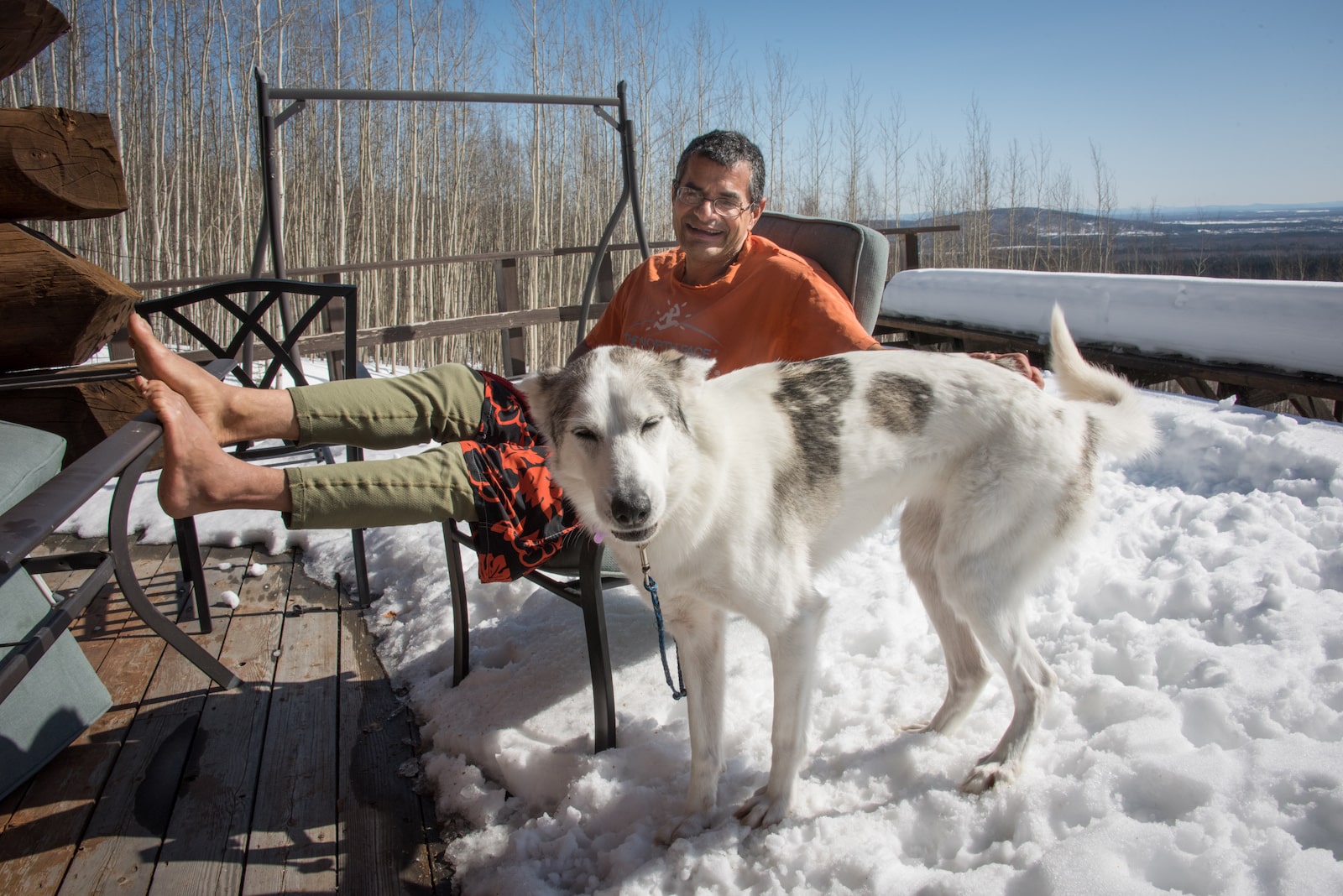
Mining companies are currently eyeing many other deposits along Alaska’s roads to make it much easier to transport their ore — including the Parks Highway, the state’s primary highway, which runs from Anchorage to Fairbanks. Kinross itself has been open about its intention to use public roads to develop other deposits, telling an industry publication there’s “an economic radius around Fort Knox, given the mill capacity, that makes a good chunk of Alaska attractive.”
There’s a near future in which many companies are trundling ore alongside tourist RVs and family minivans, compounding the risks. Yet Benowitz has a realistic view about how much outrage Manh Choh’s haul will generate — it’s so far away, most Americans can’t even picture the problems it poses. “I try not to be like, ‘No one cares about the school children, no one cares about air pollution in North Pole or Fairbanks, no one cares about the local fish,’” he says. “But they’re going to care when that’s in their state, and in their county.”
As a working geologist, Benowitz is concerned about the repercussions questioning the Manh Choh project might have on his career. “But eventually, when you see something that’s really wrong, you have to speak up. The precedent this is setting for the state of Alaska — and for the country — is horrific.”
Schuhmann also worries about backlash. She’s warned her daughter not to mention the mine in public, and to be cautious when she goes out with friends. Billions of dollars, she knows, are at stake. But she isn’t quitting. Schuhmann sends off another email to the state assistant attorney general about DOT regulations. She gives frustrated scientists matter-of-fact advice on appealing the permitting process. She tries to stay focused on the law that ought to be followed. “I don’t believe in getting angry over cases,” she says. “What’s the impact going to be for Alaskans? Those are the issues, not how I’m feeling.”

But one overcast spring day, Schuhmann walks along the Chena River with her granddaughter, watching as the season’s first trumpeter swans land in the newly open water. They pause by a bridge that 160,000 pound mining trucks will soon be crossing. “Do these companies ever really reconsider?” she asks, finally showing her exasperation. “I don’t know. It’s hard not to get depressed.”
We stand there in the snow until our toes get cold, watching as the swans front and bicker like politicians. By then, Schuhmann’s back to business. “We’ll have to just keep our thinking caps on.”
Lois Parshley is an investigative journalist. Read more of her work @loisparshley. This reporting was supported by the Fund for Investigative Journalism.
This story was originally published by Grist with the headline Alaska is facing a massive mineral boom, but at what cost? on Jul 26, 2023.
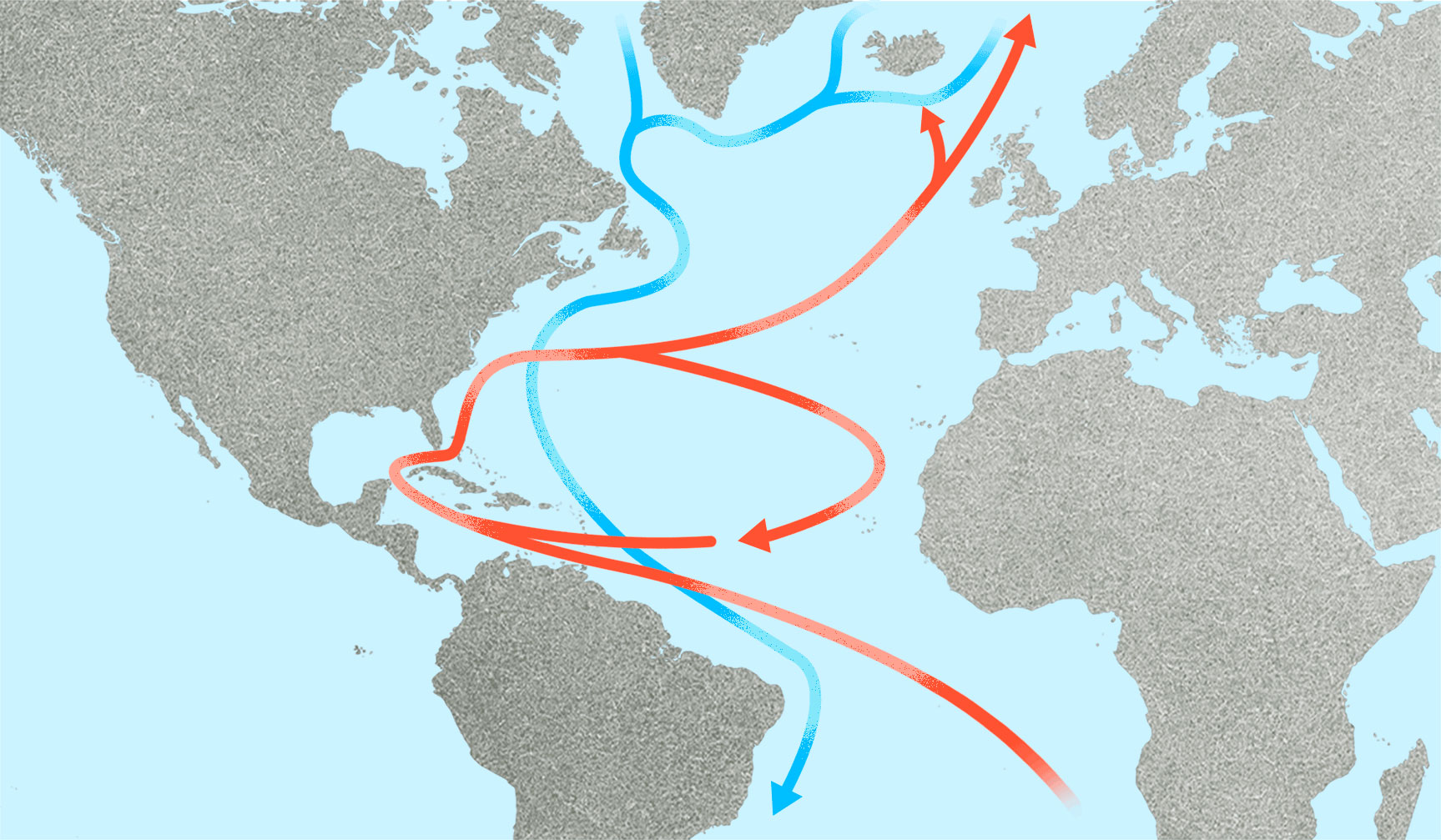
Oceans all over the world rely on a delicate balance of different elements to remain stable: Temperature, salinity, pH, and pressure all combine to create the complex bodies of water that maintain conditions for marine life and define the planet. Climate change has altered those conditions, though, by warming oceans to record-high temperatures and introducing more fresh water through sea-ice and glacier melt.
Now, new research published on Tuesday warns that a vital Atlantic Ocean system could collapse by 2060, setting off one of the planet’s tipping points, or potential points of no return. That collapse could eventually spell catastrophe for the people who live in countries that border the Atlantic Ocean, leading to increased sea-level rise in the United States, decreased temperatures and altered storm patterns over Western Europe, rejiggered climate and agricultural zones, and hotter ocean temperatures in the Caribbean.
The study, published in the journal Nature Communications, contradicts findings from the Intergovernmental Panel on Climate Change, or IPCC, the United Nations’ scientific collaboration that publishes reports on the state of climate change. The group’s latest assessment, released last year, found the collapse of the group of Atlantic Ocean currents to be unlikely given the group only acknowledges weakening of the Atlantic Meridional Overturning Circulation, or AMOC, starting in 2004. The report notes that scientists cannot say when or if a collapse will happen, since they state even the decline prior to the 2000s cannot necessarily be attributed to climate change.
“We absolutely have deep respect for the IPCC report,” Susanne Ditlevsen, a statistician at the University of Copenhagen and co-author of the study, told Grist. “When we first started, we had this idea that we could use this method that’s data-based, to kind of confirm what the IPCC report is saying. So when we actually got our first results, we were very surprised, and we didn’t believe them.”
The AMOC is a thick band of water that travels from the Gulf of Mexico north along the southeastern U.S. before heading up the western edge of Europe, carrying mild temperatures with it, and onward toward Greenland and Iceland. Once there, the current is infused with heavy, cold, and salty water that then sinks, traveling back down the coast of the U.S. This system provides what one expert with the National Oceanic and Atmospheric Administration, or NOAA, called “symmetry” to temperatures in the North and South hemispheres.

But as carbon dioxide levels rise, temperatures increase, and ice melts in the Arctic, this current is being inundated with fresh water, throwing it out of balance. This has led to a weakening of the AMOC, which recently saw its slowest point in 1,600 years in 2021.
If the web of Atlantic Ocean currents stopped, it would constitute one of the Earth’s tipping points, which signal a dramatic, potentially irreversible shift in the condition of the planet — and its habitability for humans. A study last year found that the planet has already passed a few tipping points, including tropical coral die-off and the beginning of the Greenland ice-sheet collapse, at just 1.1 degree Celsius (1.9 degrees Fahrenheit) of warming.
“We’re talking huge, huge climate changes in a very short time,” said Ditlevsen. “We would have an increase in the tropical areas … if you already have a very high, medium temperature, and it rises even higher — and that is on top of global warming. Just imagine: We have 3 billion people living there. That is a huge problem.”
The AMOC has stopped before, about 12,000 years ago, and led to a variation of about 10 to 15 degrees C (18 to 27 degrees F) within a decade. But that was during an ice age, and modern global warming is a vastly different situation.
The new research finds that this disintegration of the AMOC could occur as soon as 2025, or as far as 2095. While the findings are striking, scientists not involved in the research are approaching them cautiously.
Rong Zhang, an ocean scientist at NOAA, is skeptical of the methods used in the paper. She is particularly cautious about saying that the collapse will happen this century, let alone that it is imminent. The study uses historical records from the last 150 years to demonstrate that the weakening of the Atlantic Ocean current is accelerating. But high-quality observations of this system of currents were only established in 2004, which provides a much smaller time period to draw from.
“We need more direct AMOC observations to give us a real picture and a real early-warning signal,” she said.
Marco Tedesco, an oceanographer and professor at Columbia University, can see both sides of the argument.
Climate change necessitates that science can remain nimble and understand its increasing and exponential effects on the Earth, but also science’s precision and thorough nature of processes, like peer review, help establish and keep its authority on certain subjects, according to Tedesco.
Tedesco also notes that all the unknowns of climate change will only continue to complicate how much we can predict and measure all of those changes.
“The Earth is changing,” said Tedesco. “And it’s changing into a direction where it’s never been before, because it’s never moved so fast into that direction. And this, of course, is because of the CO2 that’s been pushed in the atmosphere in the past 100 years.”
*Correction: This story originally misspelled Marco Tedesco’s name.
This story was originally published by Grist with the headline A vital Atlantic Ocean system could collapse sooner than previously thought on Jul 26, 2023.
The chemical group referred to as PFAS (per- and polyfluoroalkyl substances) — more popularly called…
The post PFAS Contaminants: Where They Came From, Why They Persist & What We Can Do appeared first on Earth911.
Turn World Refugee Day into positive action. Join a very special conversation with actor-activist Ger…
The post Best of Earth911 Podcast World Refugee Day Special: Actor & Activist Ger Duany on the Path to Hope & Shared Prosperity appeared first on Earth911.
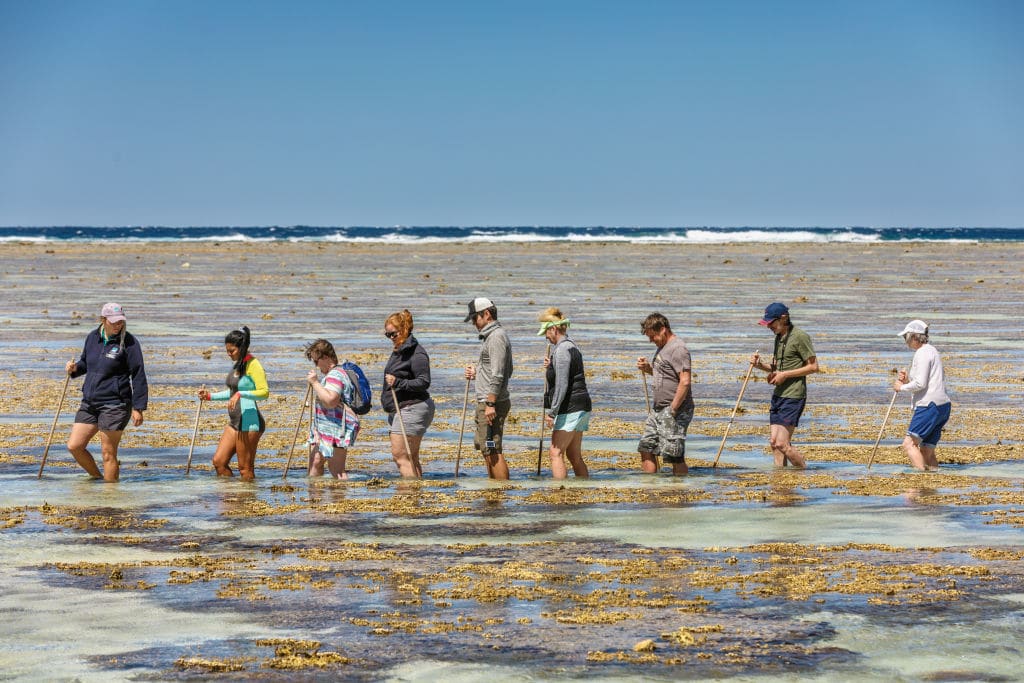
Sustainable travel can mean many things and take several forms, but in general it refers to tourism that leaves the smallest, if any, impact on ecosystems around the world while also respecting local customs and cultures. Sustainable tourism should take current and future impacts of all travel-related actions into account, such as how your visit could impact native wildlife or support the local economy.
There are many ways to embrace sustainable travel, from skipping plane rides in favor of taking a train or driving an EV to booking eco-friendly accommodations over big chain hotels. While the bulk of the responsibility for sustainable travel should still fall on the biggest polluters to make changes, like developing biofuels or building low-impact accommodations that won’t interfere with ecosystems, individuals can still make decisions to lessen their impact and signal to businesses that there is demand for more sustainable choices in travel and tourism.
Sustainably minded travelers can find many ways to travel with the environment in mind. Sustainable travel can be broken into several related categories of travel, which tourists can consider based on their destinations and preferences.
Some people love a jam-packed itinerary, where they can visit all the major sites in a city and check off all the best restaurants. But this fast-paced travel often can lead to a lot more jet-setting and use of convenience items, including single-use plastic items, in order to get from place to place as quickly as possible.
Instead, slow travel encourages a more thoughtful, drawn-out approach that emphasizes immersive experiences and giving back to local communities. Some examples may include taking the train from one city to another instead of flying, taking a cooking class instead of going to the most popular restaurants, or going to one special exhibit at a museum and engaging with visiting artists rather than trying to hit multiple museums in one day.
If hiking and camping sound like dream vacation activities, eco-tourism will be right up your alley. This form of sustainable travel is all about embracing nature, minimizing impact on landscapes and supporting local cultures tied to nature. For instance, if you’re hoping to do a guided hike, you’d sign up for one with a local guide instead of turning to a major tourism company. The goal of eco-tourism is to encourage an appreciation for nature.

Agritourism, or agrotourism, involves visiting a working farm. You may have a full farmstay, where you have lodgings somewhere on the farm, or you may just visit the farm and participate in on-site activities. To be sustainable, though, the agritourism should put animal welfare and environmental stewardship first. Some activities you could expect at an agritourism destination include picking fruits from an orchard, picking pumpkins at a pumpkin patch, attending cooking or baking classes that use fresh ingredients from the farm, or helping to feed and care for animals.
The idea behind regenerative tourism is for those participating in the tourism industry, from travelers to businesses to governments, to give more to local communities and ecosystems than they are taking. For example, someone could participate in regenerative tourism by picking up trash off the beach they are visiting, participating in a native tree planting event, or participating in other volunteer activities during your vacation.
So why do we need to focus on traveling sustainably in the first place? Although exploring the world can be good for the traveler, it isn’t always so great for Earth or the destination communities. Overtourism can damage native plants in an area or stress local wildlife, and aviation alone is a major contributor to global emissions.
As of 2018, aviation emissions make up 2.4% of total global carbon emissions, as reported by the Environmental and Energy Study Institute. The commercial aviation industry’s emissions could triple by 2050. In addition to emitting carbon dioxide, planes and jets also emit water vapor, which can influence warming even more than carbon dioxide. Aircraft also contribute to air pollution by emitting nitrous gases, including nitrogen oxide, sulfates, and soot.
When too many people crowd into an area, they can have a major impact on local ecosystems and communities. Overtourism can cause housing prices to skyrocket, and a growing issue for many communities is the rise of people buying property in tourist destinations to use as temporary rentals, leaving less housing for locals.
There are many examples of overtourism’s negative impact on nature. Back in 2018, Thailand’s Maya Bay, which became extremely popular because of the film The Beach, had to close for over four years. The area had been decimated by crowds. Litter, boat pollution and sunscreen contributed to the destruction of up to 80% of local coral reefs.
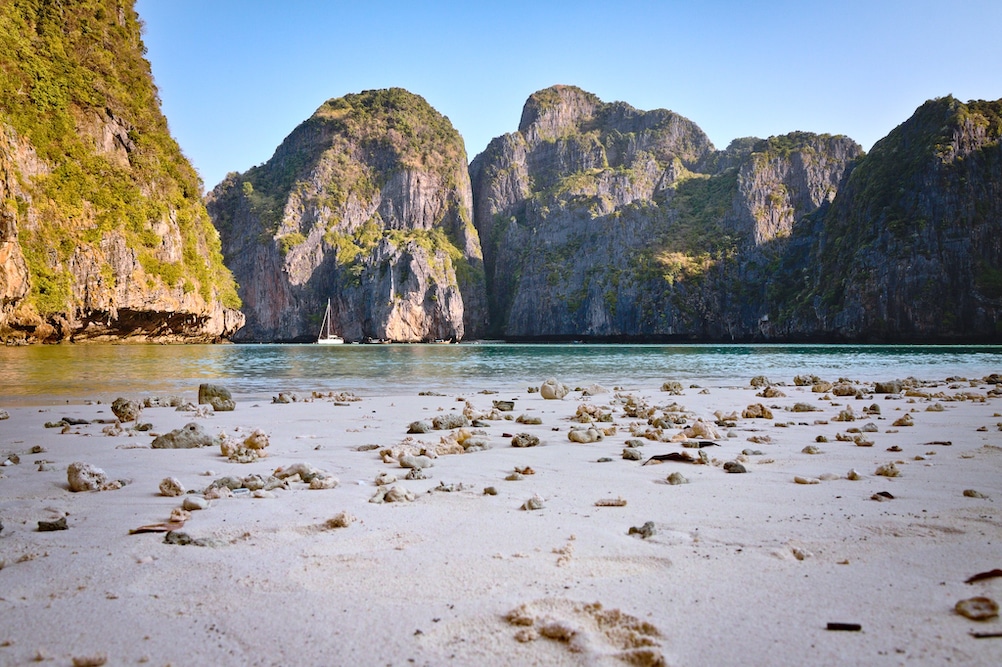
Another example close to home, the Southern California poppy superblooms often attract massive crowds. But as people idle in their cars waiting in line to find parking and trample poppies as they try to get photos, they can cause lasting damage to the area. When people step or lie on the poppies, or even step off of marked trails, they can compact the soil and prevent the poppies from regrowing in the future, as explained by the Antelope Valley California Poppy Reserve.
Think about it: the mini shampoos, body washes and lotions at hotels; the plastic water bottles at the airport; the food packaging and containers at convenience stores and restaurants. The world has a major problem with plastic pollution, and the travel industry is no exception.
The number of people traveling in 2023 is already double the amount of travelers in the same timeframe in 2022, according to the United Nations Environment Programme. Most tourists, about 80%, visit beaches and coastal regions, and as much as 8 million metric tons enter ocean ecosystems annually. This amount is expected to increase in the coming decades.
Tourism, especially when places become overcrowded with travelers, can put a major strain on resources, particularly water. Overtourism in Hawaii has left the locals to face water shortages, even facing fines for using water for certain activities, while resorts did not have to pay fines for water usage.
With the worsening climate crisis, more and more regions are facing extreme drought conditions and experiencing water shortages and restrictions, which are only made worse when more people are coming into the area as tourists, using the water without restrictions or fines. Tourists may even consume more water when traveling, especially when traveling somewhere hotter than they are used to. According to the Global Development Research Center (GDRC), tourists to the Mediterranean may consume up to 440 liters of water per day, double the average amount of water used in a city in Spain.
When you’re ready to start traveling more sustainably, you may be wondering what to look for before booking accommodations, transit tickets and even restaurants. While there’s still a long way to go in terms of reducing travel-related emissions, there are some great examples of places focused on sustainable travel, plus ongoing developments to make parts of the industry — particularly aviation — less damaging.
Many commercial airlines have made commitments to reach net-zero carbon emissions later this century, and one way to do this is by developing biofuels. Biofuels may be made from synthetic materials, agricultural waste or crops. According to the U.S. Department of Energy, the U.S. could collect about 1 billion dry tons of biomass, like corn grain, algae, oil seeds, and wood mill waste, per year that could produce 50 to 60 billion gallons of biofuels.
Some airlines, including United, Jet Blue, Emirates, Virgin Atlantic, Virgin Australia, British Airways and more, are already using fuel blends containing biofuels for select flights.
There needs to be more development here, since producing biofuels may still require land for growing crops for fuel, and biofuels will need to be combined with carbon capturing technology and carbon offsets to really make an impact.
More booking platforms are making it easier to find sustainable accommodations, especially since 76% of respondents in a recent Booking.com survey said they wanted to travel more sustainably this year. Booking.com itself and TripAdvisor offer badges and search settings to help customers find sustainably minded hotels. Google also has features to highlight eco-certified hotels.
One top example of an eco-minded lodging is the Jean-Michel Cousteau Resort in Fiji, which has been embracing sustainability since the 1990s. In addition to lessening its impact, the resort caters to regenerative tourism with its mangrove reforestation program.
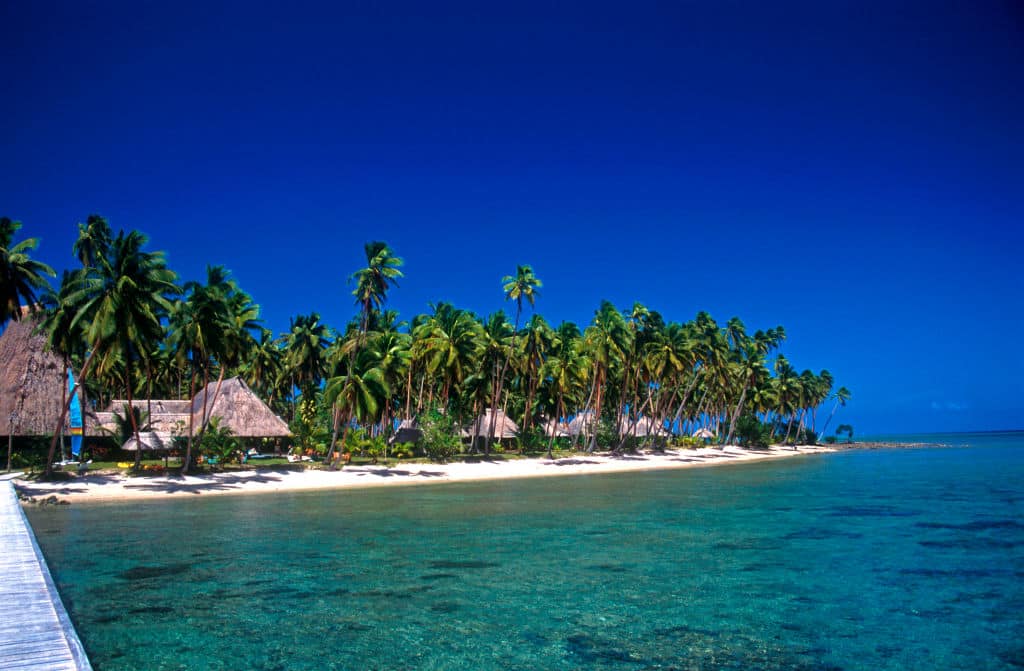
Another resort, Calilo in Greece, is also adopting a regenerative attitude toward travel accommodations. The owners have bought beachfront land on the Ios island to keep it undeveloped. It is also leading a conservation project, which has planted 68,842 olive trees so far to reforest an area destroyed by multiple wildfires and deforestation.
There are plenty more lodgings, from tiny bed and breakfasts to luxury resorts, that are working to change how we travel. Of course, if you’re not sure where to start in booking an eco-hotel, you can also explore one of the world’s greenest cities, where you’re sure to find sustainable accommodations, restaurants, transit options and more.
From visiting a vineyard for wine tastings to sitting down at a restaurant for breakfast, lunch and dinner, there are many ways you can consider the environment even when dining during your trip.
When considering wineries, you can look for places with any number of sustainability-focused certifications, including organic, Sustainability in Practice (SIP), Demeter for biodynamic wine, Low Input Viticulture & Enology (LIVE), or Lodi Rules.
For beer-lovers looking for sustainable brews, look for certifications like Craft Responsibility In Sustainable Practices (C.R.I.S.P.), B-Corp or organic, and stick to local breweries when you can for an even smaller impact.
As for restaurants, look for places offering plant-based meals, locally grown and organic produce and proteins or even farm-to-table establishments. Some top examples of the most sustainable restaurants in the world include two fine dining spots, Aponiente and Azurmendi, in Spain, the zero-waste Silo London in the UK or Uncommon Ground in Chicago, which hosts the first organic certified rooftop farm in the U.S. at one of its locations. However, these are just a few of countless restaurants globally that are focused on sustainable eats. Part of the fun of sustainable travel is finding those hidden gems on your own.
You’re not limited to hanging out in your backyard and forgoing all travel. When you want to explore the world, there are many things you can do to limit your impact.
Until sustainable biofuels are available for commercial flights, flying remains a top contributor to global emissions. Aviation makes up over 2% of all energy-related emissions, according to the International Energy Agency (IEA). If you can travel somewhere by another method, like driving (especially if you drive an EV) or even taking a train, you can lower your travel-related emissions.
When you get to your destination, keep in mind how you’re getting from your hotel to restaurants, museums, parks and other sites. Can you walk or rent a bike instead of driving? Can you make use of public transit? By doing so, you can lessen the amount of emissions from your trip.
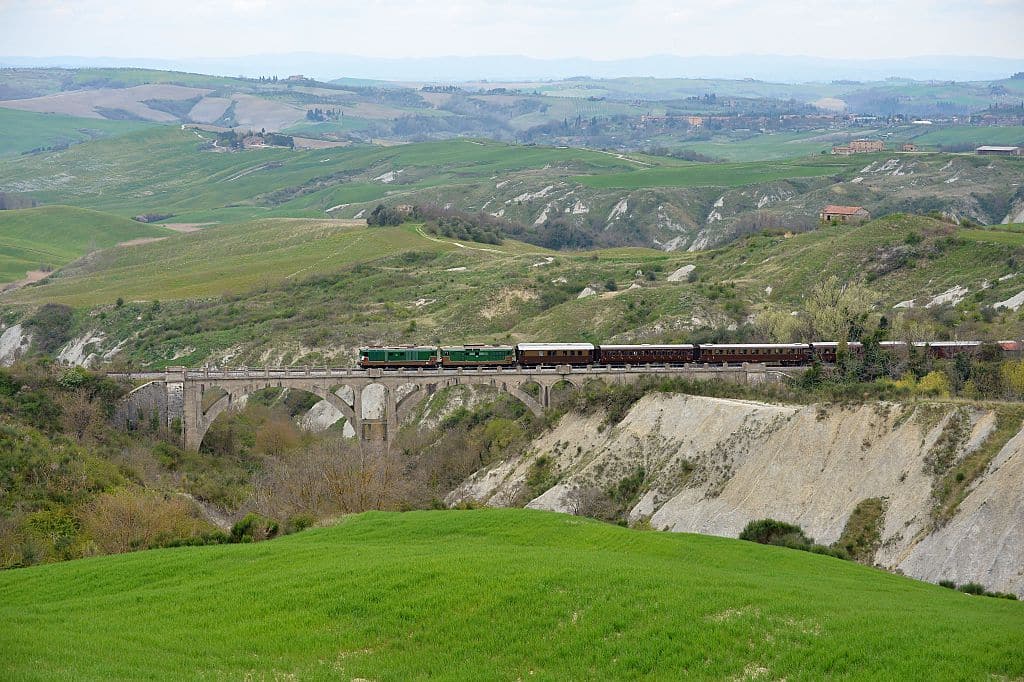
Any time you can reduce animal products in your diet is a win for the environment, even if you’re on the road. Although going vegetarian or vegan lowers individual emissions less than reducing aviation travel, you can find ways to do both to help reduce emissions. If you don’t already follow a vegan or vegetarian lifestyle at home, consider eating more plant-based meals during your travels.
While your travel rewards points may make it appealing to stay with a major hotel chain, opt for locally owned accommodations instead to better support the local economy and community. No matter where you decide to stay, do your research. Support lodgings with green credentials and sustainable efforts beyond simply only providing toiletries on request or only cleaning the room by request. Some certifications to look out for include EarthCheck, Audubon Green Lodging Program, Green Globe Certification, Green Tourism Active Global and Green Key Global.
Reducing your landfill waste is a great way to lessen your impact on ecosystems around the world. Not only does following a zero-waste approach reduce waste management emissions by around 84%, but it also saves energy and water while keeping trash out of landfills, oceans, and other ecosystems.
It’s easy to opt for convenient packets of food in single-use packaging, plastic water bottles or plastic forks and spoons when you’re traveling, but a little planning can make a zero-waste trip just as convenient. When you’re putting together your packing list, make sure to bring reusables, like water bottles and utensils, snacks in reusable containers, cloths for drying your hands or washing off makeup and other reusables.
Similar to the idea of a zero-waste trip, you can also adopt the “leave no trace” principal, especially for nature-focused adventures like hiking excursions or camping trips. With a zero-waste approach in mind, you’ll already be planning ahead and packing plenty of reusables. But the idea of leave no trace is to make sure to pack out any waste and personal items from an environment when you’re leaving, so your items do not disturb wildlife. Dispose of any waste as directed, and don’t take pieces of the ecosystem with you (for example, don’t pick any flowers or take any shiny rocks out with you). Take photos instead.
One of the best ways to spend money while traveling is to support local businesses. Rather than buying mass-produced keychains and T-shirts, you can purchase art or textiles made by local artisans. Dine at unique restaurants rather than stopping for fast food or spending money at a chain restaurant. When choosing a tour guide company, look for locally operated teams rather than booking with a major global entity. In addition to supporting the economy by buying things locally, make sure you are supporting communities by respecting their local customs and cultures.
Circuses, roadside zoos, aquariums and other sites that utilize animals as entertainment have a dark reputation for mistreating animals. Italy and New Jersey have even banned animals for circuses, as they often face abuse.
Instead of giving money to companies that mistreat animals and take wild animals out of their natural habitats, you can still connect with animals on your trip by participating in local volunteer opportunities. You can find a list of sanctuaries around the world via The Global Federation of Animal Sanctuaries website, or you can look for accredited zoos that rescue animals that can no longer live in the wild. For especially adventurous travelers, consider the Natural Habitat Adventures by World Wildlife Fund.
To further minimize your impact on a region, try traveling during the off-season or opt for less touristy destinations. This can help alleviate stress put on local ecosystems as many people arrive and explore an area at once. It also limits the strain on resources, which can leave communities short of enough water, food, energy and other necessities. Plus, you get to see more of your destination without being stuck in crowds or long lines.
Travel was on the rise until the global COVID-19 pandemic brought things to a halt. But now that the pandemic has been downgraded from an emergency level, travel is ramping up faster than ever. But that means more emissions that contribute to climate change, and overtourism threatens ecosystems and communities.
But all hope is not lost. Businesses, from local restaurants and vineyards to major airlines and hotel chains, are working to lessen their impact on the planet. Developments in aviation and carbon capture technology can help reduce aviation-related emissions. New search functionality and eco-certifications can help direct travelers to book sustainable hotels. And individuals can adopt their own approaches, like traveling to less touristy destinations or adopting a zero-waste lifestyle, at home or abroad to minimize the impact of travel. Ultimately, we’ll all need to work together to make traveling less harmful if we want to keep the planet in good health.
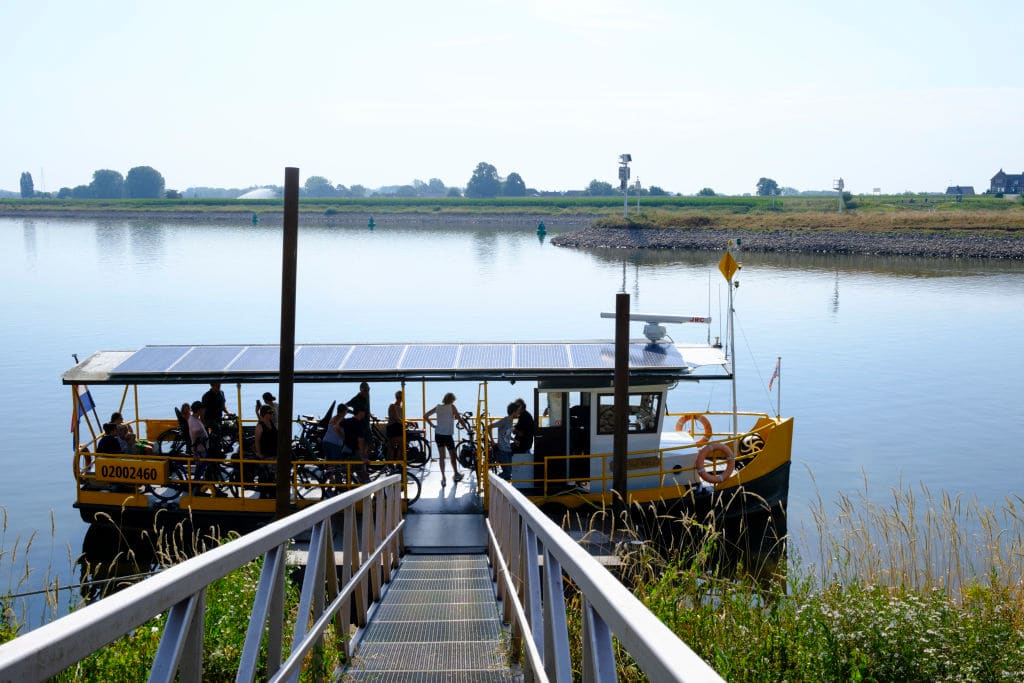
The post Sustainable Travel 101: Everything You Need to Know appeared first on EcoWatch.
Like the dry land on the surface of our planet, the ocean’s depths are made up of a variety of terrain, from plains and canyons to volcanic seamounts. Scientists believe there are as many as 10 million undiscovered marine species living on the ocean floor.
Multiple new studies have found that a vast area at the bottom of the Pacific Ocean that is being targeted for destructive deep-sea mining — the Clarion-Clipperton Zone (CCZ) — is home to thousands of unknown species that are more complex than scientists once believed.
Miners of minerals used in electric vehicle batteries and other green energy technologies have been looking at this abyssal plain for “nodules” on the seafloor that contain the minerals.
In a new study, an international team of scientists looked more closely at the biodiversity of this underwater region between Hawaii and Mexico. The researchers mapped marine animals’ distribution in the CCZ and discovered their communities were more complex than once thought.
“Abyssal seafloor communities cover more than 60% of Earth’s surface. Despite their great size, abyssal plains extend across modest environmental gradients compared to other marine ecosystems. However, little is known about the patterns and processes regulating biodiversity or potentially delimiting biogeographical boundaries at regional scales in the abyss,” the authors of the study wrote. “Improved macroecological understanding of remote abyssal environments is urgent as threats of widespread anthropogenic disturbance grow in the deep ocean.”
The study, “Carbonate compensation depth drives abyssal biogeography in the northeast Pacific,” was published in the journal Nature Ecology and Evolution.
Along with the interest in mining the region has come more exploration and discoveries through commercially funded deep sea expeditions, reported AFP.
Among the wonders of this dark, watery world include a shrimp with long, bristly legs, an enormous sea cucumber called the “gummy squirrel,” soft-bodied anemones, glass sponges and many types of mollusks, crustaceans and tiny worms.
Conservationists have been calling for a moratorium on deep-sea mining, but last week the International Seabed Authority gave the go-ahead to a two-year plan for adopting a set of mining regulations.
“We are on the side of the ocean,” said Gina Guillén Grillo, Costa Rica’s representative to the Seabed Authority who has helped lead the opposition to seabed mining, as The New York Times reported. “We know there is not enough science. To start right now would be a disaster.”
More than half of Earth is covered in abyssal plains that are over 9,843 feet underwater. Erik Simon-Lledó, a marine biologist from Britain’s National Oceanography Centre, who was also the lead researcher of the study, called these regions the “last frontier.”
“Every time we do a new dive we see something new,” Simon-Lledó said, according to AFP.
Mining disrupts the seabed, causing large plumes of sediment that can wipe out habitat and smother delicate organisms. Nodules containing the sought-after minerals are also the homes of specialized marine animals.
“With the science as it is at the present day, there is no circumstance under which we would support mining of the seabed,” said Sophie Benbow of the NGO Fauna and Flora, as reported by AFP.
The unique array of marine life in the CCZ is due to the region’s size and age, but essential to its stunning biodiversity is the fact that it has remained undisturbed.
According to the study, more than 90 percent of the approximately 5,000 species documented in the CCZ are new to science.
Adrian Glover of Britain’s Natural History Museum, who was a co-author of the study, said mining regulations would need to consider that the distribution of marine creatures in the CCZ is “more complex than we thought.”
Glover explained that each nodule likely took millions of years to develop and began as a shard from a fish ear bone or shark tooth that had settled on the ocean floor. The nodules grew slowly over time as minerals found at very low concentrations in the water naturally accumulated on them.
The CCZ is ancient and adds only one centimeter of sediment every thousand years. Because the environment has been undisturbed for what Glover said is tens of millions of years, recovering from any mining would take an unknown amount of time.
“You are basically writing that ecosystem off for probably centuries, maybe thousands of years, because the rate of recovery is so slow,” said Michael Norton, Environment Programme Director for the European Academies’ Science Advisory Council, as AFP reported. “It’s difficult to argue that that is not serious harm.”
The post Ocean Depths Targeted for Mining Are Rich in Complex and Unknown Marine Life, Scientists Find appeared first on EcoWatch.
Paris is referred to as the City of Light and the City of Love, and, until 1923, it was also a city of swimming. That year, swimming was banned in the Seine due to excess sewage being drained into the river following heavy rainfall, rendering the iconic river unsafe.
An exception to the ban was the swimming competition, Traversée de Paris à la Nage, which continued into the 1940s, according to Paris Unlocked.
Paris is gearing up for the Summer Olympic Games next year, and is in the final phase of a decade-long, $1.6 billion project to restore the Seine and make it swimmable once again, reported BBC News and France 24.
“When people see athletes swimming in the Seine with no health problems, they’ll be confident themselves to start going back in the Seine,” said Pierre Rabadan, deputy Paris mayor in charge of the Olympics, as BBC News reported. “It’s our contribution for the future.”
Not only was the waterway being polluted with toxic wastewater, but all sorts of trash was being dumped into it, from plastic and cigarette butts to bicycles. Each year, around 386 tons of garbage is removed from the elegant artery dividing Right Bank from Left Bank, reported France 24.
Much of the fecal bacteria that had historically been deposited into the Seine has been eliminated thanks to better practices being implemented in the past 20 years.
“But the difficulty has been in eradicating those last few percentage points to ensure it can be officially classified as clean,” said Samuel Colin-Canivez, chief engineer for sanitation at Paris city hall, as BBC News reported.
An underground reservoir has been built to collect runoff following a deluge, rather than using the river as an overflow site.
Colin-Canivez said there could be rare exceptions when an overflow of wastewater gets into the river, but in those cases it would be deemed “unbatheable.”
The Seine will be used for Olympic events next year, as well as for the games’ opening ceremony.
For years, hardly any fish or other marine species were seen in the Seine, but 30 to 35 species of fish have returned, according to Bill François of the Paris fishing federation, as well as aquatic insects, crayfish, molluscs and sponges.
Back in 2009, wild Atlantic salmon came back to the river in droves after an absence of nearly a century, with hundreds spotted swimming past the Eiffel Tower, researchers told AFP at the time.
“The bottom of the river is developing a coat of the right kind of weed. The clearer the water, the more the weed grows, and then the weed filters the water to make it even clearer — it’s a virtuous circle,” François said, as reported by BBC News.
Three places along the Seine have been designated for public bathing beginning in the summer of 2025, announced to Paris Mayor Anne Hidalgo: Bras de Grenelle, Bras Marie and Bercy, according to Time Out.
With temperatures soaring across Europe due to climate change, anywhere people can cool off safely in the summer will surely be welcome.
“It will create waves, so to speak, across the world because a lot of cities are watching Paris,” said Dan Angelescu, a scientist who has been tracking water quality in the Seine for city hall, as Euronews reported.
The post Paris to Make Seine Swimmable Again After a Century appeared first on EcoWatch.
The Council of the EU has passed a new law to add more fast-charging stations and alternative fuel stations throughout the EU. As part of the new regulations, the EU will require fast-charging stations, with a total output of 400 kW for cars and vans and 600 kW for heavy-duty vehicles, to be installed every 60 kilometers (about 37 miles) along highways by the end of 2025.
The new law on alternative fuels infrastructure is meant to greatly reduce the carbon footprint of transportation in Europe and contributes to the Fit for 55 goal to reduce emissions in the EU by 55% or more by 2030. As The Verge reported, transportation makes up about 25% of all greenhouse gas emissions in the EU.
“The new law is a milestone of our ‘Fit for 55’ policy providing for more public recharging capacity on the streets in cities and along the motorways across Europe,” Raquel Sánchez Jiménez, Spanish Minister of Transport, Mobility and Urban Agenda, said in a statement. “We are optimistic that in the near future, citizens will be able to charge their electric cars as easily as they do today in traditional petrol stations.”
The law requires fast-charging stations for electric vehicles along main highways that are part of the the trans-European transport (TEN-T) network by 2025, and these stations should have at least one fast-charger with 150 kW or greater output.
Recharging stations with a total output of 600 kW, including at least one charger with a minimum 150kW output, for heavy-duty EVs must be placed every 60 kilometers in the core network of TEN-T and every 100 kilometers (about 62 miles) in the larger TEN-T network by 2025. The charging stations should cover the complete TEN-T network by 2030, according to the law.
By 2030, hydrogen fuel stations will need to be installed every 200 kilometers (about 124 miles) along the TEN-T core network and in all urban nodes, or urban areas that include parts of the TEN-T network’s transportation infrastructure.
The charging and alternative fuel stations should offer easy payment options, such as contactless payments or payment by card, without requiring subscriptions. Transparency is a key component of the law, with pricing, availability and wait times made clear to customers under the new rules.
In addition to the rules on recharging and refueling stations for cars, vans and heavy-duty vehicles, the law requires some maritime ports, depending on whether they meet a minimum number of large passenger or container vessels, to offer shore-side electricity by 2030. It also mandates that airports must offer electricity for stationary aircraft at all gates by the 2025 deadline and at remote stands by 2030.
The EU already offers a significant number of fast-charging stations, with more than 70,000 stations as of 2022, a 55% increase from 2021, according to the International Energy Agency. Germany, France and Norway lead the charge with the highest numbers of fast chargers. With the new legislation, added fast chargers with transparency on pricing and availability could help reduce range anxiety and encourage more people to switch to electric vehicles.
The post New EU Law Requires Fast-Charging Stations Along Highways by End of 2025 appeared first on EcoWatch.
Eco-conscious homebuyers on a budget have a new choice, 3D-printed homes made from low-carbon cement….
The post 3D-Printed Homes Come With a Lower Carbon Footprint appeared first on Earth911.